The blog describes a trip to Sevilla, Spain in 2007, featuring a Flamenco show at El Palacio Andaluz and exploring the city's iconic landmarks such as the Cathedral of Sevilla and Plaza de España. The next day, it visited Granada, home to the Alhambra Palace with its stunning gardens and architecture, including the Generalife palace and Sacromonte hill with its cave dwellings and traditional shops selling Iberian hams.
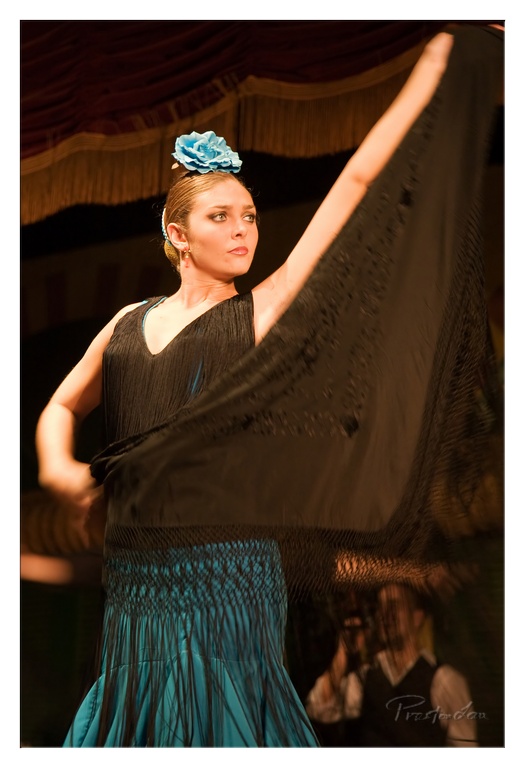

Flamenco Flourish
Rating: 8/10
Caught in a moment of impassioned motion, this flamenco dancer is the undisputed star of the show, rated a solid 8 for her compelling presence. Her body forms a dynamic line reaching skyward, amplified by the dramatic sweep of a black shawl that billows around her like a storm cloud of elegance. Perched atop her head is a striking blue flower, a vibrant punctuation mark against the dark backdrop of her hair and costume, matching the intricate blue fringed skirt that provides a splash of color at the bottom of the frame. Her expression is intense, eyes fixed on a distant point, embodying the fiery soul of flamenco. Behind her, the stage is a wash of dark, blurred forms and textured curtains, hinting at the live performance setting and leaving the focus squarely on the captivating artist in the foreground.
From a photographic standpoint, the composition leans heavily into capturing the energy of the performance, with the raised arm and trailing shawl creating powerful diagonal lines that inject dynamism. The lighting is classic stage drama – a focused spotlight illuminating the dancer while plunging the background into shadow, perfect for isolating the subject but perhaps hiding interesting stage details. The use of color is effective, with the pop of blue providing contrast against the predominantly dark palette. The motion blur on the shawl is a deliberate stylistic choice, enhancing the sense of movement, even if it means losing some detail. It's a strong capture of a peak moment, proving that sometimes, just pointing the camera at pure passion is the best technique.


Flamenco Passion in Polka Dots
Rating: 9/10
This vibrant capture plunges us into the heart of a passionate flamenco performance, focusing on a dancer caught mid-movement, her arms elegantly raised as if reaching for the dramatic sky above. She's a splash of electric lime green covered in large, cheerful pink, orange, and white polka dots, a sartorial choice that screams "fiesta!" Her gold drop earrings catch the light, complementing the yellow fan-like hairpiece nestled in her bun, adding flashes of brilliance against the dark stage backdrop. In the blurry background, another dancer in a red shawl is seen clapping, while a gentleman in a suit offers a shadowy presence, hinting at the full ensemble providing the rhythmic soul of the performance. The overall mood is one of dynamic energy, cultural richness, and focused intensity, perfectly embodying the spirit of flamenco.
From a photography perspective, this shot is all about isolating the star and her energy. The composition is a tight crop on the main dancer, emphasizing her powerful pose and flamboyant dress, although the slightly off-center framing gives it a candid, dynamic feel. The lighting is classic stage drama – a strong spotlight hitting the front, creating highlights on her skin and dress while plunging the background into shadow. This high-contrast lighting works wonders for separating the subject but can be tricky; thankfully, it doesn't completely blow out details here. The color palette is bold and effective: the bright, almost neon green and colorful polka dots pop beautifully against the deep, dark background, while the hints of red from the other dancer add a touch of complementary warmth. It's a style typical of performance photography, aiming to freeze a peak moment of action and emotion, successfully conveying the intense atmosphere of the show, though getting that background perfectly sharp without sacrificing the main subject in low light is always the fun challenge, isn't it?
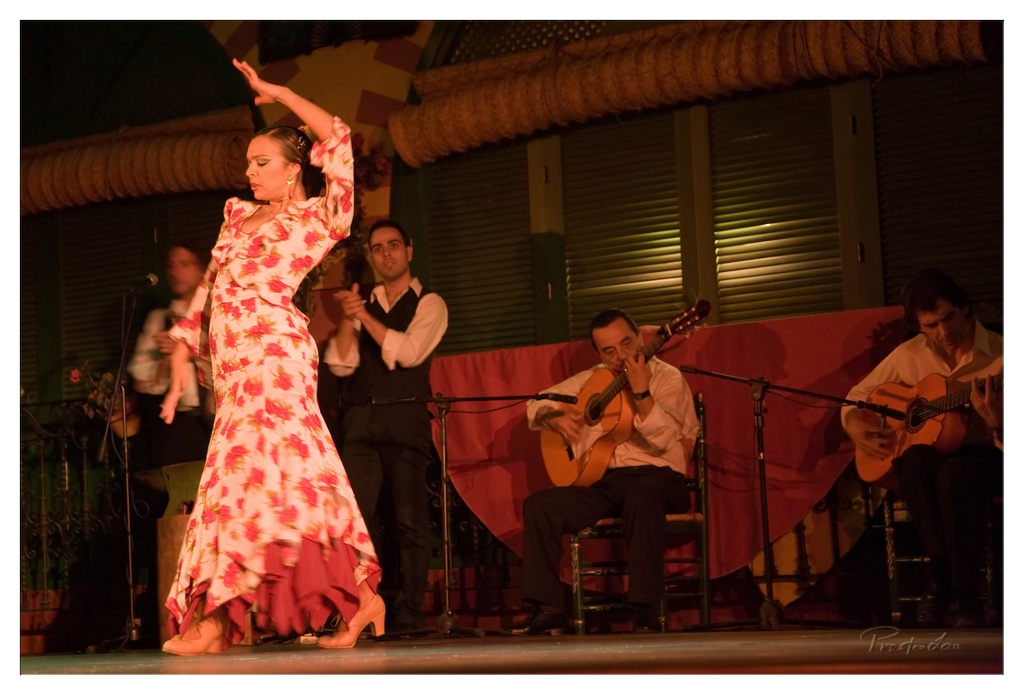

Passion and Poses on the Flamenco Stage
Rating: Subject - 9/10
Stepping onto the stage with the fiery passion of flamenco, our captivating dancer takes center stage, her arm raised high, caught in a moment of intense motion. Adorned in a vibrant floral dress that seems to echo the energy of her steps, she embodies the spirit of this dramatic art form. Flanking her are the dedicated musicians – a clapping *palmero* looking ready for a standing ovation, and two guitarists providing the essential rhythmic and melodic backdrop. The atmosphere is electric, pulsing with the raw emotion and theatricality inherent in flamenco, pulling the viewer directly into the heart of the performance, despite the slightly off-center framing which emphasizes the dancer's dynamic movement.
From a photographic standpoint, capturing the dynamism of flamenco is no small feat. The composition places the star dancer prominently, her striking pose dominating the left frame, while the supporting musicians on the right attempt to balance the visual weight – a classic challenge in stage photography! The stage lighting, while challenging, casts a warm glow that enhances the dramatic reds and oranges of the setting and the dancer's dress, though it leaves the background of textured walls and green blinds a bit murky. The motion blur on the dancer's lower half hints at a courageous attempt to convey movement, or perhaps the photographer just needed a faster shutter speed and a prayer – the life of performance photography, right? Those microphones, ever-present guardians of sound, do slightly intrude on the visual flow, but they're part of the raw, live scene set against the bold red fabric, reminding us this isn't a posed studio shot, but a slice of genuine cultural expression.
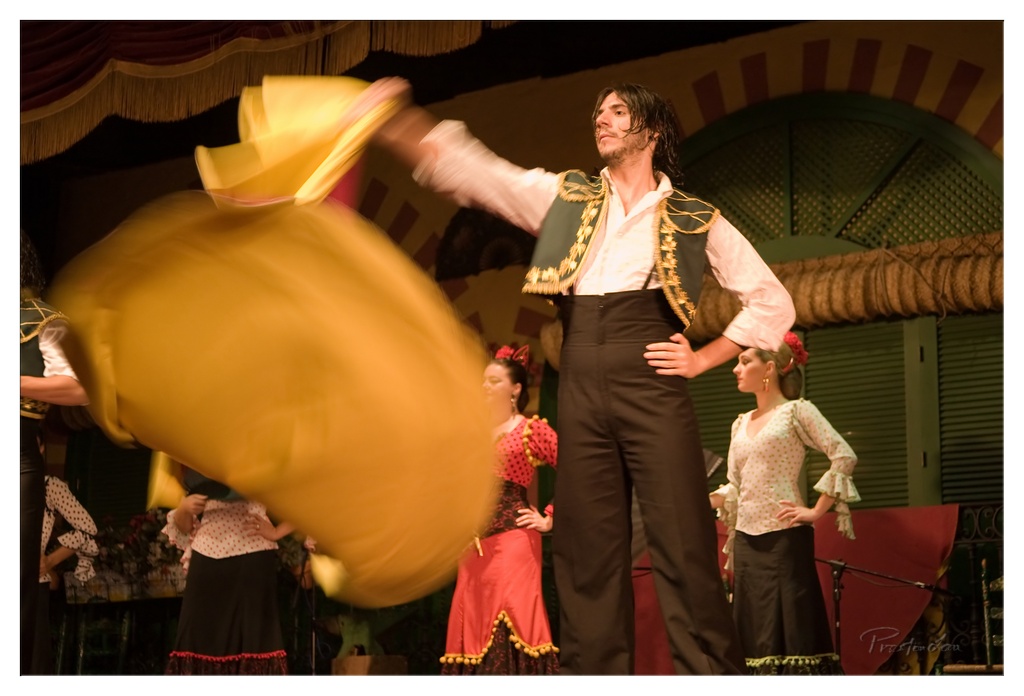

Flamenco Fury, Served with a Side of Blur
Subject Rating: 7/10. The performers themselves are charismatic and visually striking subjects, embodying the passion of flamenco. However, the composition is heavily dominated by a large, undefined blur, which detracts slightly from the human subjects at the center of the action.
A lively flamenco performance unfolds on stage, capturing a moment of intense energy. The central figure, a male dancer in a traditional embroidered vest and high-waisted black pants, strikes a classic pose with hand on hip, radiating confidence. Behind him, other dancers in colorful, ruffled dresses add depth to the scene, their own poses and movements suggesting the rhythm and flow of the dance. The most eye-catching, or perhaps eye-blurring, element is the massive, swirling mass of yellow on the left, clearly a prop like a large scarf or skirt being moved at incredible speed, its motion rendered as a dynamic, abstract shape that threatens to steal the spotlight entirely. The mood is theatrical and passionate, a snapshot of the dramatic flair inherent in flamenco.
From a photographer's perspective, this image is a bold attempt to capture the sheer dynamism of the performance. The composition leans heavily on the diagonal sweep of the yellow blur, which creates a strong sense of motion but also occupies a significant portion of the frame, perhaps obscuring other interesting details. Lighting is typical stage setup, highlighting the performers reasonably well against the darker background of curtains and a painted backdrop featuring arched window-like structures. The colors are vibrant on the costumes, contrasting nicely with the more subdued stage elements. The style leans towards capturing energy over sharpness, using motion blur to convey speed. While the blur is a bit overwhelming, it undeniably communicates the rapid, expressive movements. For future shots, perhaps experimenting with faster shutter speeds or slightly different angles could help balance the capture of movement with clearer subject detail, unless the goal was specifically 'Abstracted Flamenco by Giant Yellow Blob,' in which case, nailed it!
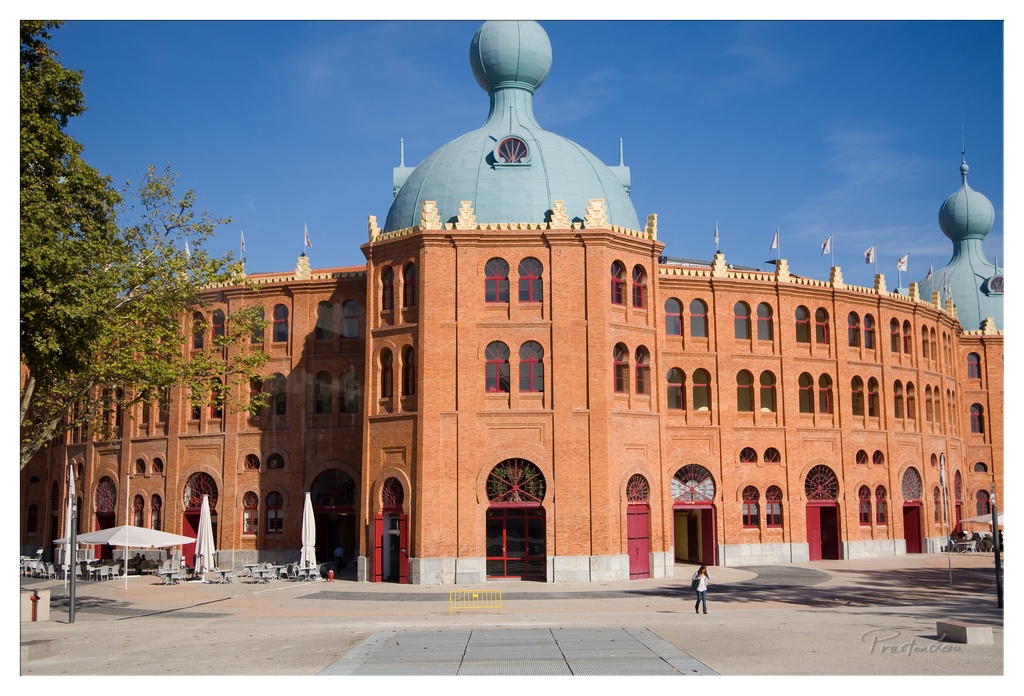

Campo Pequeno Grandeur
Rating: 8/10
This image captures the imposing beauty of the Campo Pequeno bullring in Lisbon, a truly grand piece of Moorish-inspired architecture. The subject is easily a 9/10 – it's a magnificent structure with incredible detail, from the vibrant orange brickwork to the distinctive blue domes. The scene depicts a quiet day in the plaza surrounding the bullring, with scattered groups enjoying the sunshine at outdoor cafes while a lone figure walks across the foreground. The mood is one of relaxed grandeur, a sense of timelessness juxtaposed with the everyday activity of the city square.
From a photographic perspective, the composition is solid, anchoring the massive building towards the right and allowing the eye to appreciate its scale against the clear blue sky. The tree on the left provides a nice natural counterpoint to the built environment. The lighting is bright and contrasty, typical of a sunny day, beautifully highlighting the texture of the bricks and creating strong shadows that add depth. The colors are rich – the warm oranges and reds of the brick pop against the cool blues of the domes and sky. It's a classic architectural shot, perhaps leaning a little heavily on the central placement of the main dome, but effective in conveying the scale and detail. A slightly lower angle emphasizes the building's height, making you feel small in its presence, which is either a deliberate artistic choice or perhaps just the photographer trying to fit it all in! And yes, that single person walking on the right feels just a *little* posed, like they were strategically placed for scale, or maybe they just *really* needed coffee.
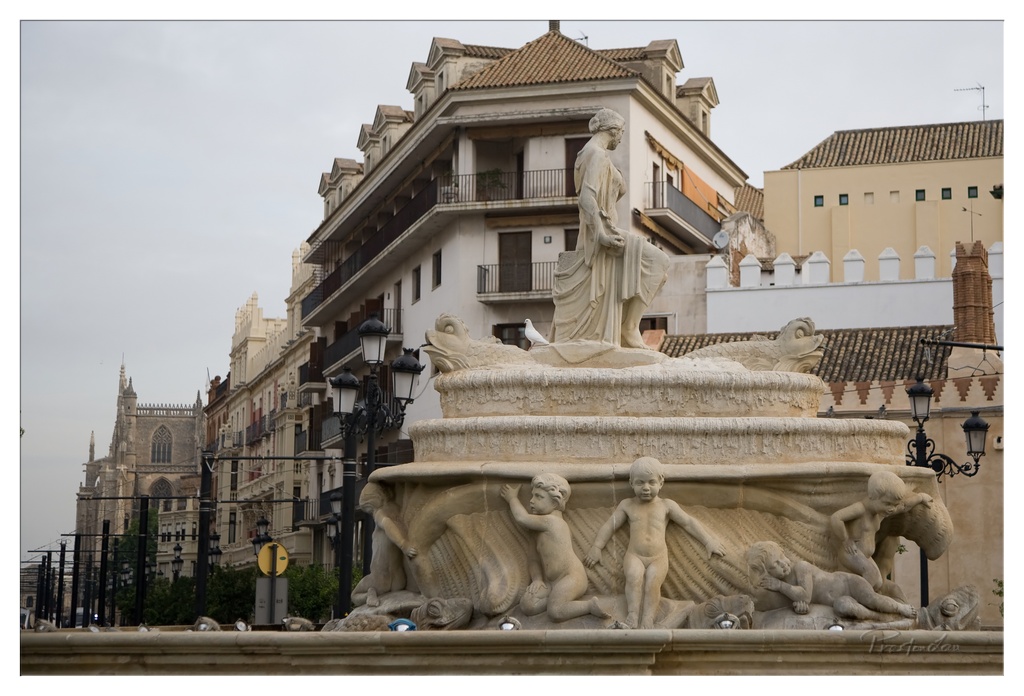

A Cloudy Day with Some Very Still Friends
Subject Rating: 8/10
This photograph captures a grand stone fountain featuring multiple statues in the foreground, set against a backdrop of European architecture under a predictably gray, overcast sky. Atop the fountain sits a regal, draped female figure in a classical pose, seemingly contemplating the eternal flow of water that isn't currently flowing (or perhaps just contemplating her perpetually wet feet). Around the base, a charming collection of stone children and mythical sea creatures (or just really excited fish) are depicted interacting with the water feature, appearing frozen mid-frolic. Pertinent objects include ornate black street lamps lining the left side, a metal fence or railing, and what looks like a pigeon adding a fleeting touch of life to the otherwise stony assembly. The background reveals a street scene with historic buildings of varying heights and styles, culminating in the spires of a large gothic-style building in the distance on the left, all contributing to the scene's timeless, slightly melancholic mood.
From a photographic perspective, the composition is solid, placing the impressive fountain front and center, dominating the lower two-thirds of the frame and drawing the eye directly to the sculptural details. The line of buildings receding into the distance adds depth and context, though the large expanse of featureless gray sky feels a bit... gray. The lighting, courtesy of the overcast conditions, is perfectly even, which is fantastic for highlighting the intricate carving on the stone figures without harsh shadows – every little detail, crack, and moss patch is laid bare. It's great for documentation, less so for drama. The color palette is muted and natural, reflecting the materials and the sky, making it feel grounded and realistic, if not particularly vibrant. The style leans towards documentary or architectural photography, capturing a specific place and its features. If only the sun had peeked out for a moment, maybe the children would have looked less like they just remembered they left the oven on.
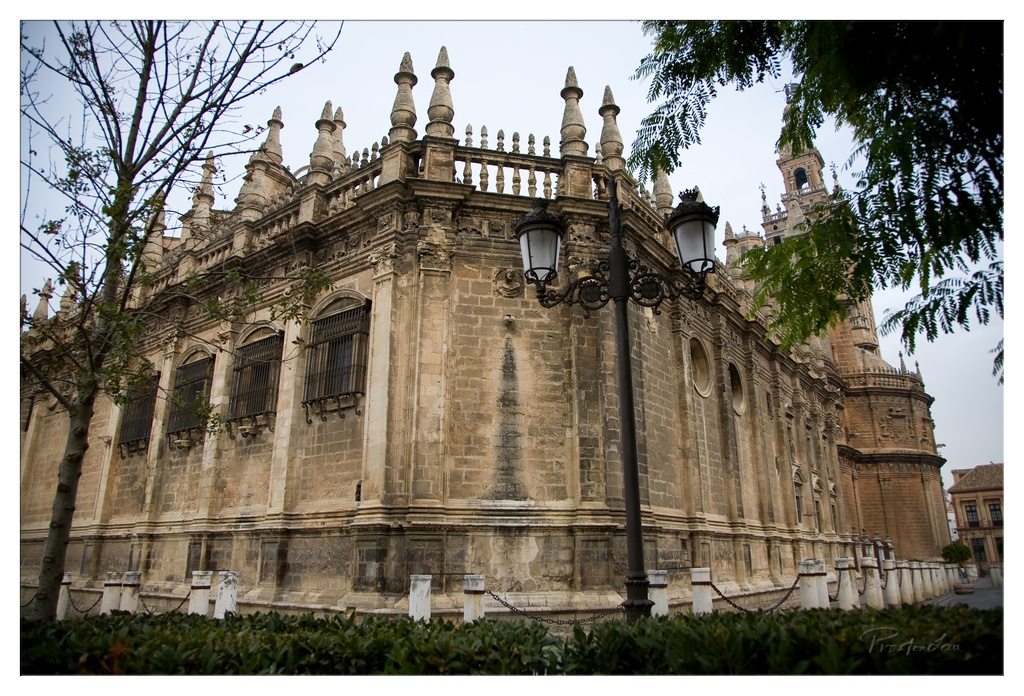

Majestic Stone Sentinel
Subject Rating: 9/10
Alright, let's cast our eyes upon this grand old dame! We're staring up at what appears to be a rather significant piece of historical architecture, likely a cathedral or a similarly impressive stone structure, earning a solid 9/10 just for sheer scale and detail. On this particular day, absolutely nothing eventful is happening – it's a serene, if slightly moody, moment captured under an overcast sky. The mood feels weighty, historical, perhaps a little solemn, amplified by the muted palette and the sheer presence of the building. Front and center, trying its best to steal the show, is a rather handsome vintage lamppost, standing sentinel while a bare-branched tree provides a skeletal frame on the left, all set against a backdrop of grey skies and distant structures, including a tall tower that seems to be part of the same monumental complex and a smaller residential building peeking in on the far right.
From a photography perspective, the composition here is... interesting. The low angle effectively emphasizes the building's imposing height and the intricate details of its architecture, which is great, highlighting the numerous spires and the decorative balustrade. However, the central lamppost placement is a bold choice that simultaneously anchors the foreground and inconveniently obstructs a clear view of the facade – it's like a well-dressed gentleman accidentally walking into your epic panorama shot. The lighting from the overcast sky is flat, rendering the intricate stone texture less dramatic than it might be under more dynamic light, although it does avoid harsh shadows, resulting in a muted, somewhat desaturated color palette dominated by browns, greys, and greens from the foreground bushes and chain-link fence. While the subject matter is undeniably magnificent, the photo feels slightly held back by the compositional clutter and the flat light. And let's not forget that signature bravely attempting to blend in down in the corner!
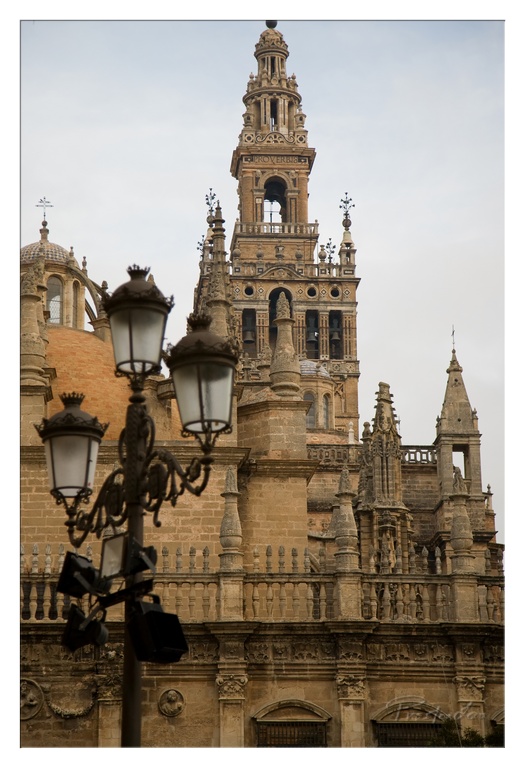

Title: The Lamp and the Not-Quite-Foreground Attraction
Rating: 6/10
Behold, a stunning historical edifice, potentially the magnificent tower of a cathedral or grand public building, majestically rising towards a soft, grey sky. Or at least, most of it is visible. Prominently placed in the foreground, demanding your attention with its multi-headed glow-worm style lamps and associated rigging, is a street lamp. This isn't just any street lamp; it's *the* street lamp, determined to be the star, or at least a significant co-star, in this architectural drama. Behind this metal monarch, the building reveals intricate stone carving, arched windows, decorative balustrades, spires reaching like stone fingers towards the heavens, and even the faint outline of bells and an inscription. The mood is one of historical weight and quiet grandeur, punctuated by the decidedly un-grand presence of modern street furniture.
Critically speaking, the subject matter is compelling – the architecture offers a wealth of visual interest and detail. However, the compositional choice to place the large, out-of-focus street lamp so prominently in the foreground is questionable. While it might have been intended as a framing element or to add context, it largely serves to obscure the main subject and creates an unbalanced feel. The lighting is soft and even, courtesy of the overcast conditions, which is kind to the textures but also flattens them slightly, robbing the scene of dramatic highlights and shadows that could emphasize the architectural depth. The muted color palette enhances the historic feel but doesn't add much vibrancy. It's a classic example of how foreground elements can either elevate or detract from a shot; in this case, the lamp is less of a helpful guide and more of a bossy obstacle.
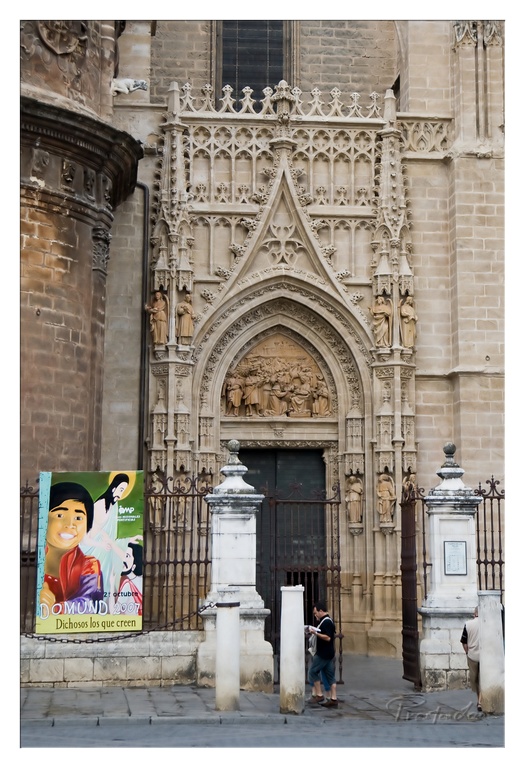

A Divine Advertisement?
Rating: 6/10
Well, if you ever needed proof that even magnificent Gothic cathedrals aren't immune to modern-day marketing, here it is. This frame captures a slice of life playing out before a stunning, intricately carved stone portal, adorned with statues and relief sculptures that scream "centuries of history and devotion." But wait, what's that? A giant, vibrantly colored poster is propped up right in front of the majestic wrought-iron gate! It features a smiling person and Jesus, advertising "DOMUND 2007" and proclaiming, "Blessed are those who believe." It’s a fascinating, if slightly jarring, juxtaposition of the sacred and the promotional, the ancient and the relatively new. Meanwhile, a man casually reads something near a white pillar, seemingly unfazed by either the architectural grandeur or the evangelical billboard, embodying the mundane amidst the monumental. The mood feels like a typical day at a tourist spot or religious site, where the daily bustle happens against an epic historical backdrop.
From a photographic perspective, the vertical composition effectively captures the height and detail of the portal, drawing the eye upwards towards the intricate stonework and the darker rectangle of the upper window. The lighting is rather flat, likely from an overcast sky or late afternoon, which softens the shadows on the stone carvings but also makes the brightly lit poster jump out dramatically. The color palette is a study in contrasts: the muted, earthy tones of the weathered stone and ironwork are violently interrupted by the poster's bold blues, greens, and oranges. While the architectural subject matter is undeniably rich, the inclusion and prominence of the poster and the casually framed people shift this from a pure architectural study to more of a documentary or street scene captured in front of a famous building. One might question the composition's balance, where the eye is pulled in multiple directions – the magnificent portal, the eye-catching poster, and the human activity in the foreground. It's less a perfectly composed shot *of* the cathedral and more a snapshot *at* the cathedral, complete with its modern-day accoutrements.
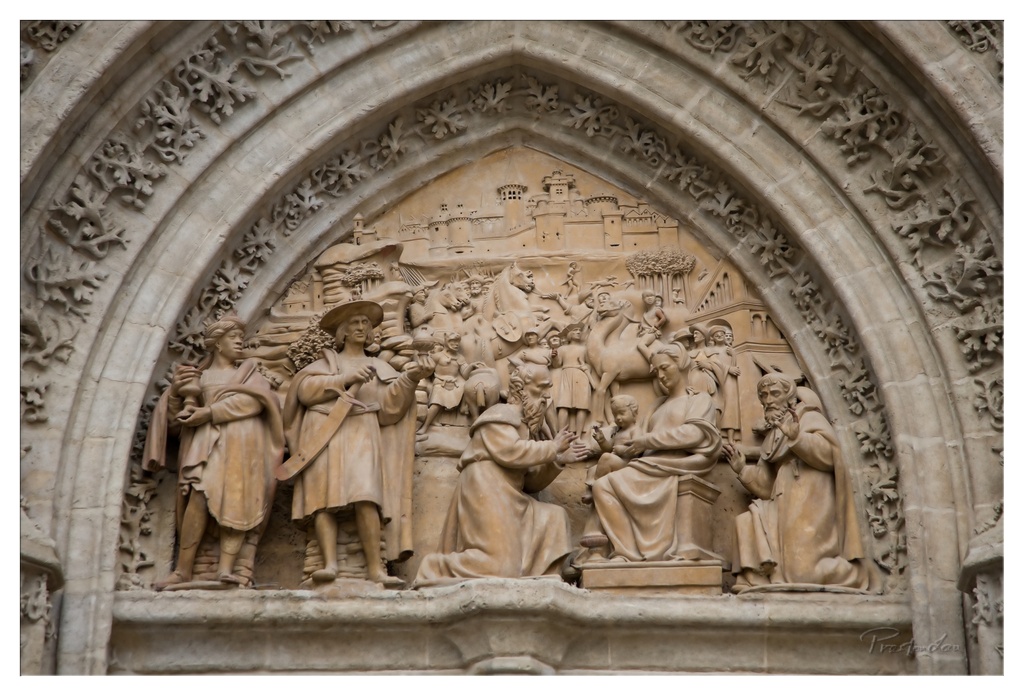

Stone Stories: Adoration in Relief
Rating: 8/10
This striking image captures a detailed stone relief sculpture adorning an architectural arch, most likely part of a church facade. The primary subject is a bustling scene depicted in raised carving, centered around a seated figure holding a child, perhaps the Virgin Mary and Baby Jesus. Around them, figures are shown offering gifts and kneeling in reverence, strongly suggesting this is a representation of the Adoration of the Magi. In the background of the relief, a lively procession winds its way forward, complete with figures on horseback and leading camels, approaching a stylized depiction of a walled city or townscape. The mood is one of historical reverence and intricate storytelling carved into enduring stone, though one might wonder if the sculptor ever got tired of chiseling tiny camels.
From a photographic perspective, the composition is solid, using the ornate, foliage-decorated arch as a natural frame for the central relief, guiding the eye directly to the main narrative. The lighting is particularly effective here; natural light hitting the relief from the side creates crucial shadows that dramatically enhance the depth and texture of the carving, making the figures and details pop out from the stone. Without this clever play of light and shadow, the scene would look far flatter. The monochromatic color palette of the stone beige and grey reinforces the historical nature of the subject, preventing any color distractions from the complex forms. It's a great example of how careful framing and leveraging natural light can elevate the capture of architectural details, making the ancient art come alive again for the viewer – no flash needed, thankfully, as that would be a cardinal sin against textured stone.
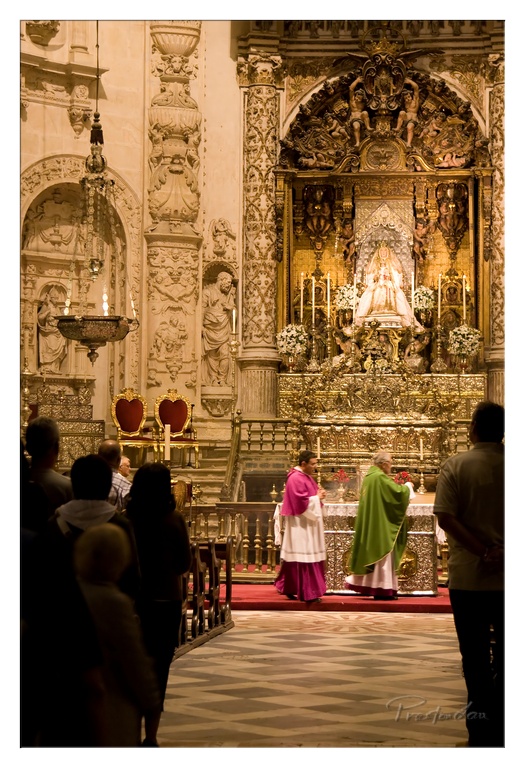

Mass Appeal: A Gilded Gathering
Rating: 8/10
Stepping into this frame feels like being transported to a moment of deep reverence within a magnificently ornate church. The subject, a religious ceremony unfolding before a breathtakingly elaborate and gilded altar, rates a solid 8 out of 10 for its rich detail and evocative atmosphere. What's happening is clearly a sacred service, with two priests performing rites while a small congregation watches from the pews. The mood is undeniably solemn and historical, steeped in tradition and the palpable weight of centuries. The central element is the incredibly detailed altar, a dazzling display of gold, statues, and candlelight, arguably containing more precious metal than your average pirate's retirement fund. In the foreground, people are silhouetted, their attention fixed forward, acting as quiet observers to the sacred drama. The background is a symphony of baroque splendor – soaring columns, intricate carvings, and the grand altar itself.
From a photographic standpoint, the composition cleverly uses the congregation in the foreground to frame and lead the eye towards the brightly lit altar, creating a sense of depth and participation, even from the back. The lighting is dramatically high-contrast; the deep shadows in the foreground transition sharply to the brilliant, warm glow emanating from the altar, effectively drawing focus to the main action. The color palette is dominated by the warm golds and creams of the architecture, punctuated by the vibrant liturgical colors of the priests' vestments – a striking green and a regal purple – and the rich reds of the sanctuary furniture, adding visual anchors in the opulence. While the extreme contrast can make detail in the shadows tricky to discern, it successfully amplifies the mystical quality of the scene. It's a challenging low-light shot that captures the grandeur and spiritual intensity of the moment, making you feel like a silent witness to history.
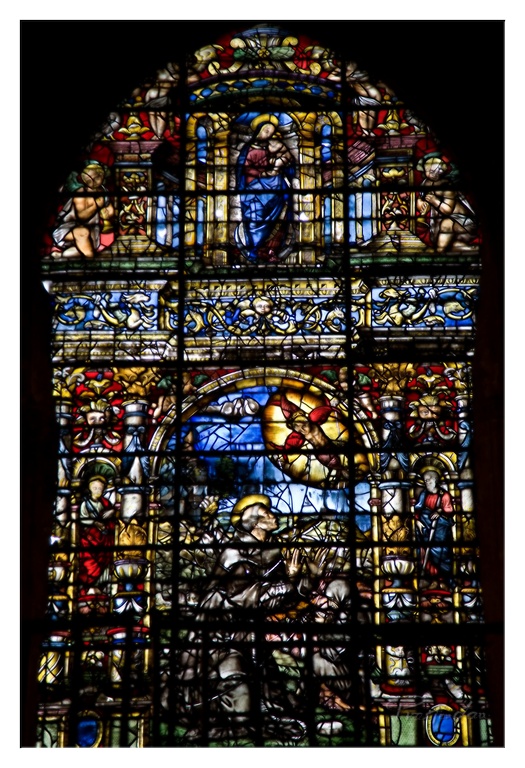

Medieval Light Show
Rating: 7/10
This photograph captures a magnificent stained glass window, a riot of color depicting what appears to be various religious scenes, culminating in a central panel of the Virgin Mary and Child at the top. It's like someone took a box of jewels, melted them down, and told a very long, illustrated story with the result. The mood is certainly reverent and awe-inspiring, as intended by the original artisans, but the photographic capture adds a layer of dramatic intensity thanks to the natural backlighting. Below the divine duo, the window is segmented into further narratives, featuring figures bathed in heavenly light, intricate patterns, and architectural elements rendered in vibrant glass. You can almost hear a Gregorian chant just by looking at it. The sheer density of detail, from the expressions on the faces to the swirling decorative motifs, speaks volumes about the craftsmanship and the rich symbolic language of the era.
From a photography perspective, this is always a tricky subject, balancing the bright highlights of the glass against the darker lead lines and potentially shadowy surroundings. The composition here is straightforward and effective, centering the arched window and allowing the eye to wander through the segmented stories. Lighting is provided by the sun (or artificial light mimicking it), which brilliantly illuminates the colored glass, making it glow like embers. The color rendition is fantastic, showcasing the deep blues, rich reds, and glowing yellows that are characteristic of antique stained glass. While generally in focus, capturing sharp detail through leaded glass from a distance is tough, but the photographer has managed to convey the intricate design reasonably well. The challenge is always ensuring the bright areas aren't blown out while retaining detail in the darker sections, and this image largely succeeds, giving us a luminous glimpse into a timeless work of art.
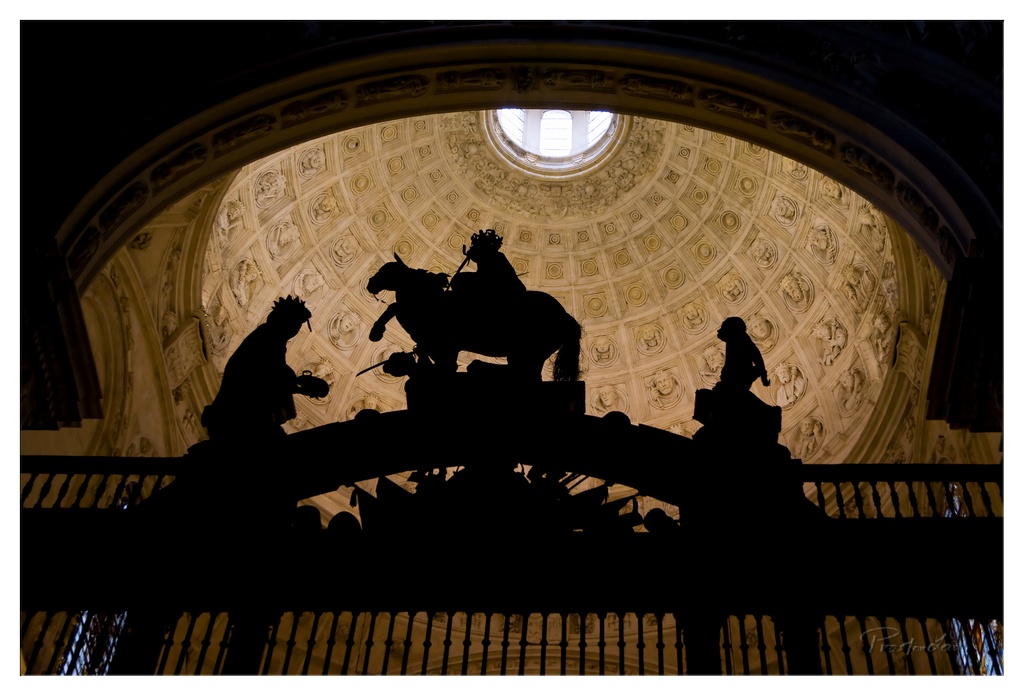

Celestial Spectators
Subject: 9/10
This dramatic image plunges us into a world of shadows and light, where three mysterious figures, including a striking silhouette of a person on horseback, are perched on a dark structure against the backdrop of a magnificent, soaring dome. The figures are rendered in absolute black, creating powerful silhouettes that stand in stark contrast to the brilliantly illuminated, ornate ceiling above. The dome itself is a spectacle of intricate geometric patterns and numerous sculptural reliefs, glowing with a warm, golden light filtering down, possibly from a small window at its apex. There's a palpable sense of scale and grandeur, almost as if these silent observers are dwarfed by the heavenly expanse above them, locked in quiet contemplation or perhaps just admiring the impeccable plasterwork, giving the subject a solid 9 for sheer enigmatic presence.
Photography-wise, this is a stunning example of how to use backlighting to maximum effect. The complete lack of detail in the foreground subjects pushes all focus onto their form and the incredible background. The composition utilizes the dark structure in the foreground as a natural frame, leading the eye upwards towards the richly detailed dome. The exposure is spot-on for the bright background, which is crucial for a successful silhouette, ensuring the detail and texture of the dome are not blown out. The limited colour palette, dominated by the golden hues of the dome and the deep black of the silhouettes, enhances the sense of drama and timelessness. It’s a brave choice to sacrifice foreground detail, but here it absolutely works, transforming simple figures into iconic, almost mythical presences against an architectural marvel.
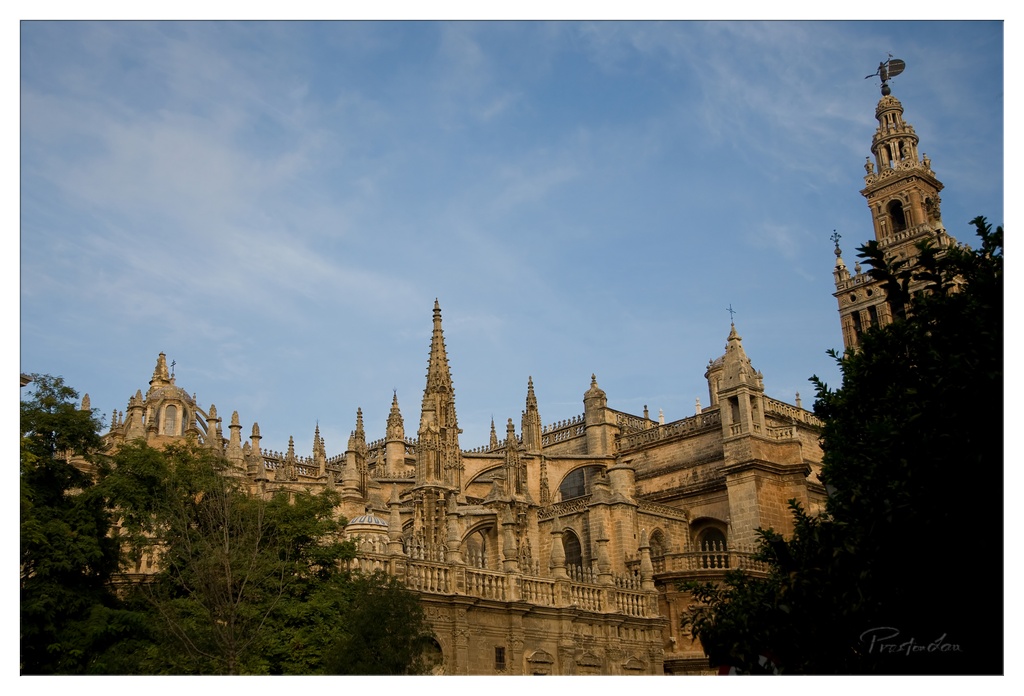

Seville Cathedral Grandeur
Rating: 7/10
Ah, the majestic Seville Cathedral, truly a subject worthy of worship... or at least a solid 9/10 on the architectural grandeur scale. This shot captures the sheer scale and intricate detail of this historical behemoth, its many spires and flying buttresses reaching towards the heavens like the world's most elaborate set of stone knitting needles. We're clearly looking up from street level, craning our necks just like countless tourists before us, trying to fit the whole magnificent mess into a single frame. The mood is one of awe and ancient majesty, though perhaps slightly tempered by the feeling that the building might just topple over onto us at any moment due to the extreme perspective. The Giralda tower looms on the right, its weather vane silhouetted against the sky, a silent sentinel over the scene.
From a photographer's perspective, this is a classic low-angle approach to emphasize height, which works well here. However, the composition feels a touch constrained, with the Giralda tower getting a slightly awkward haircut on the right edge – perhaps step back or pan left next time? The trees in the foreground, while providing a bit of organic contrast to the stone, do feel a tad intrusive, like nature just *had* to photobomb the shot. Lighting appears to be from a lovely golden hour, painting the stone in warm hues, although the sky is a bit bright, suggesting the dynamic range challenged the sensor. It's a good effort at capturing the scale, but wrestling with foreground elements and getting the whole iconic tower in frame is the real challenge with buildings this big.
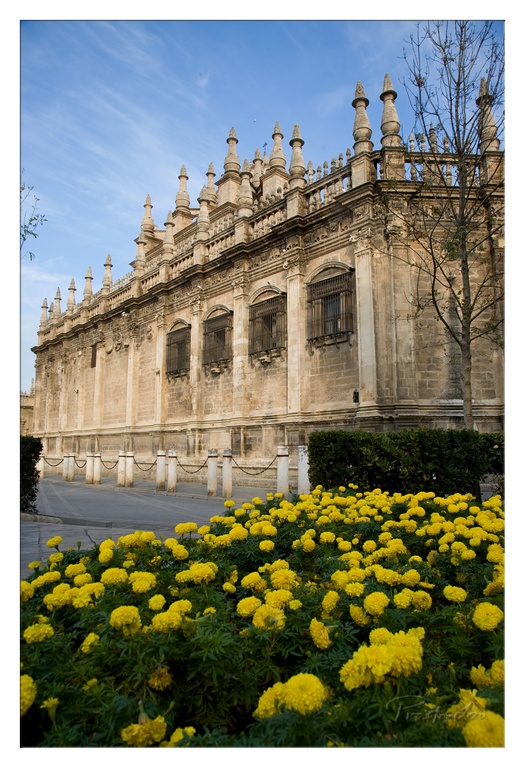

Grand Building, Garden Party
Subject: 8/10
Well hello there, burst of sunshine! This image practically screams "Spring has arrived, and brought its loudest yellow friends." Our main subject, a magnificent, highly decorated old stone building, stands proudly (rating 8/10 because seriously, look at those spiky bits on top, they mean business). It's just standing there, looking ancient and important, perhaps contemplating its architectural life choices, while a veritable sea of bright yellow flowers throws an enthusiastic garden party right in front of it. The mood is a charming blend of historic grandeur meeting floral exuberance; it's formal architecture attempting to maintain dignity while being serenaded by a choir of overly cheerful blossoms.
From a photographic standpoint, the composition is dominated by that vibrant yellow foreground – a bold move that successfully draws the eye but makes the grand building feel a tad like a backdrop to nature's enthusiastic display. The lighting is pleasant, casting nice detail on the stonework and making those yellow petals glow like tiny suns, contrasting beautifully with the solid grey of the building and the clear blue sky above. The bare tree on the right adds a touch of seasonal reality to the otherwise perfect scene, preventing it from being *too* perfect. It's a classic travel shot, expertly balancing impressive architecture with a lively splash of color, making you want to book a ticket immediately (just maybe bring sunglasses for the flowers).
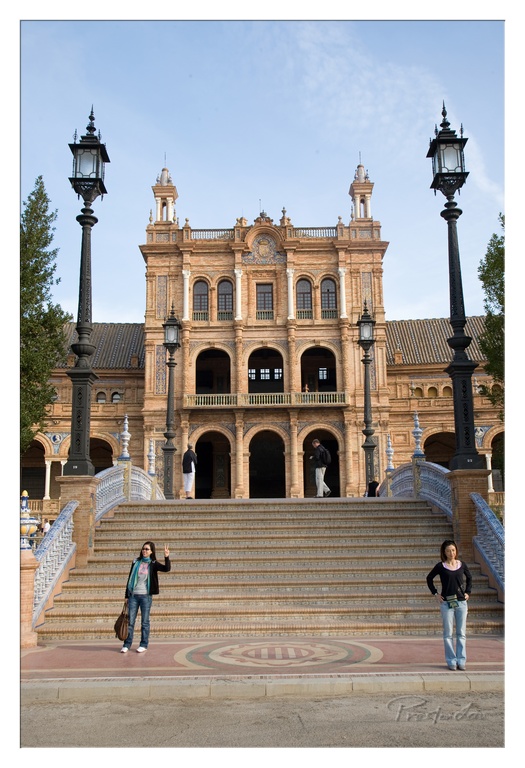

Grandeur and Poses
Rating: 9/10
Step right up to the magnificent Plaza de España in Seville, a breathtaking architectural subject that truly deserves a high rating for its sheer scale and beauty. Here, beneath a wide sky, we see the sprawling, ornate palace facade with its arched walkways and balconies, flanked by imposing street lamps and bordered by grand stairs leading upwards. Down at the base of this impressive ascent, two tourists have found their spot to perform the age-old ritual of the souvenir photo, striking poses that are as classic as the architecture itself, while other visitors dotted along the stairs and balconies provide a sense of human scale against the monumental backdrop. The mood is one of stately grandeur mixed with casual tourism, highlighting the intersection of historical magnificence and modern-day travel.
Photographically speaking, the composition employs strong vertical elements from the lamps and trees to frame the central building, utilizing the staircase as a leading line towards the primary subject. The shot captures the symmetry of the building well, though the amount of patterned ground in the foreground feels slightly disproportionate, drawing attention away from the stairs themselves. The lighting is soft and even across the building facade, suggesting a favorable time of day for architectural photography, avoiding harsh contrast and allowing the warm brick and tile details to stand out against the pale blue sky. While the building is the undisputed star, the human subjects, with their determined poses (the classic peace sign makes an appearance!), introduce a touch of relatable, slightly awkward reality into the majestic scene. It's a solid wide shot that effectively documents the location, though one might ponder whether the photographer's true subject is the building, the people, or the inherent, amusing contrast between the two.
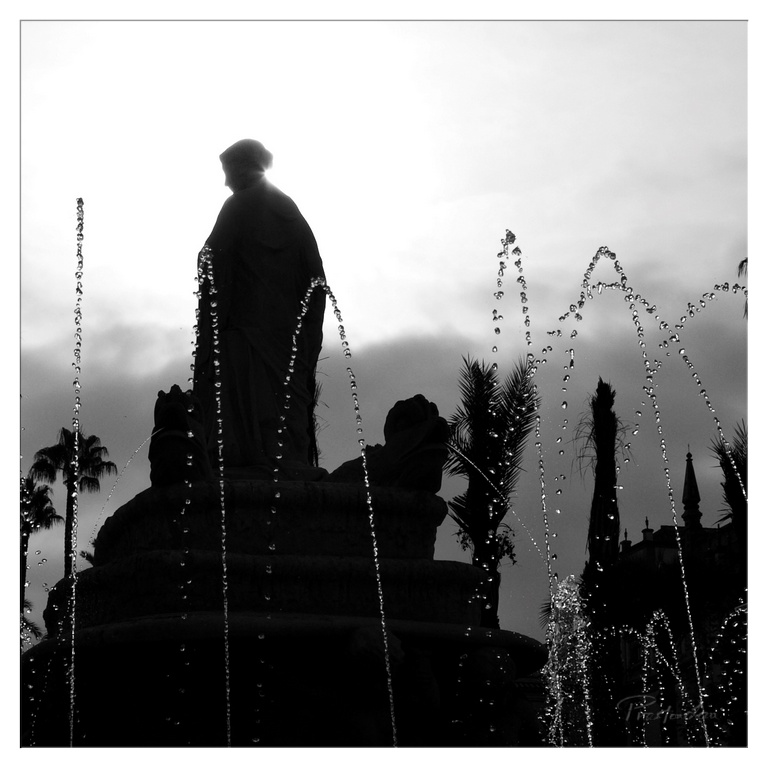

Silhouetted Solitude
Subject Rating: 6/10
Captured in stark monochrome, this image presents a dramatic silhouette of a robed statue, standing stoic atop a multi-tiered fountain base. The statue is positioned slightly off-center, its form obscured by the intense backlighting from the bright, cloudy sky. Water jets arc and spray dynamically around the figure, creating sparkling lines of droplets that act as a lively counterpoint to the static subject. In the background, silhouetted palm trees and distant architectural spires add a touch of exotic mystery and urban context. The overall mood is one of dramatic tension, perhaps even a touch of melancholy, enhanced by the high contrast and the anonymity of the silhouetted figure. It feels like a quiet moment before something significant happens, or perhaps a figure lost in time, surrounded by the constant flow of the present.
From a photographic perspective, this is a masterclass in working with challenging light. The deliberate use of backlighting creates a powerful silhouette, stripping away detail but emphasizing the form and presence of the statue. It's a bold choice that pays off, giving the image its strong dramatic impact. The composition is well-considered; the low angle enhances the statue's dominance, while the vertical and arcing lines of the water jets are expertly placed to frame the subject and add visual interest without overwhelming it. The monochrome conversion is essential here, amplifying the contrast between the dark foreground elements and the bright sky, which would likely have been less impactful in color. It effectively isolates the elements of light, shadow, and shape, making the image feel timeless and evocative. My only critique? The statue looks a bit like it's giving a dramatic reading while being constantly sprayed – perhaps it just needs an umbrella and a good spotlight instead of harsh backlighting. But hey, who needs comfort when you have *artistic vision*?
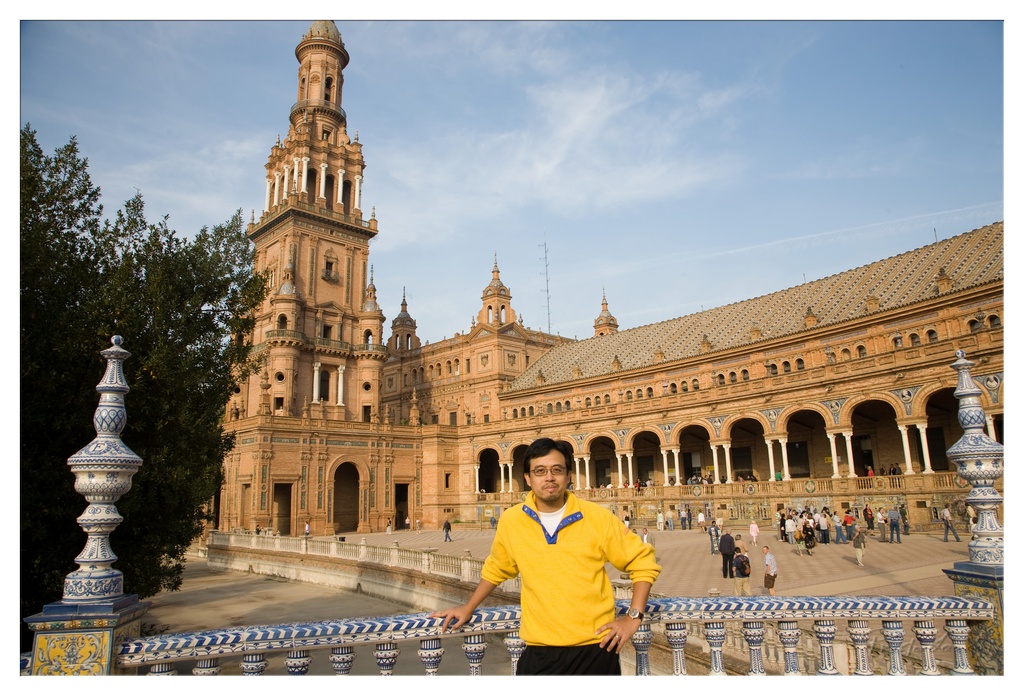

Plaza Pose with a Pop of Yellow
Subject Rating: 6/10
Here we have our intrepid traveler, striking a classic "I was here!" pose in front of a truly spectacular backdrop that appears to be the Plaza de España in Seville. Donning a vibrant yellow fleece that practically shouts "Look at me!", he leans casually (or perhaps bracingly) against an equally ornate, tiled railing. What's happening? Our subject is documenting his presence in this magnificent location, likely for posterity or social media bragging rights. The mood is one of proud tourism – capturing the moment amidst grand architecture. He stands tall, hands awkwardly resting, ensuring he's the focal point despite the visual feast behind him. The yellow sweater provides a much-needed splash of color against the warm, earthy tones of the building, creating a noticeable contrast, though one might argue it competes a bit with the stunning tiled railing in the foreground.
From a photographic perspective, the composition is a classic tourist snapshot, prioritizing the subject *with* the landmark. The intricate blue and white tiled railing in the foreground adds depth and local flavor, but its prominence creates a strong horizontal line that slightly anchors the bottom, potentially distracting from the man and the building. The background scene is undeniably the star of the show, featuring the sweeping arcade of the building complex, leading the eye into the vast plaza bustling with other visitors. The lighting seems warm, suggesting late afternoon, which bathes the building in a lovely glow and illuminates the subject well. However, the pose feels a tad stiff, perhaps benefiting from a more relaxed posture or interaction with the environment rather than just standing in front of it. While perhaps not a masterclass in portraiture or landscape composition, it successfully captures the essence of being there, yellow sweater and all, a cheerful memory preserved against a backdrop of Spanish splendor.
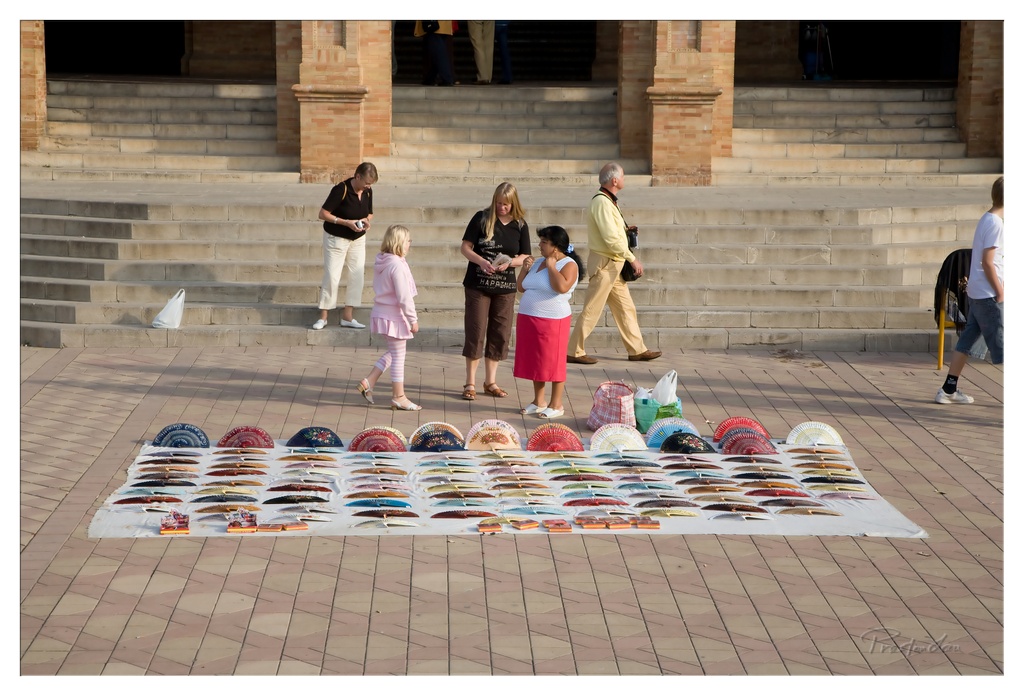

Fans for Sale, Life in Parallel
Subject Rating: 7/10
Ah, the classic scene of tourist commerce! Laid out like a vibrant mosaic on a simple white sheet, dozens of decorative fans command the foreground, acting as the colourful main subject of this sun-drenched tableau. In the middle ground, a handful of potential patrons and passersby meander or pause. We see a vendor engaging with one woman while a child skips past, and other figures drift in and out of the frame near the grand, imposing stairs that dominate the background. It's a snapshot of daily life in a public space, capturing the low-key interaction between vendor and tourist against a backdrop of historic architecture. The mood is casual and observational, a quiet moment amidst the potential hustle of a tourist hotspot, where practical elegance is being offered up on a sheet.
From a photographic perspective, the composition places the array of fans front and center, creating a strong horizontal line and a repetitive pattern that's visually appealing, though perhaps a touch overwhelming. The lighting is typical of a sunny day, casting sharp, well-defined shadows from the fans and figures onto the paving stones – great for geometry, less great for soft portraits, but it emphasizes the textures. The colours are warm and inviting, with the reds, blues, and golds of the fans contrasting nicely with the earthy tones of the stone steps and pavement. The style is documentary, capturing a candid moment without apparent posing. While the subject matter of street vending isn't groundbreaking, the sheer quantity and variety of fans provide an interesting visual element. The people are perhaps a little scattered compositionally, feeling less like an integrated group and more like individual figures caught in motion around the central display. The background of the large stairs adds scale and context, reminding us this isn't just any street corner, but a place of some significance, where even the simple act of selling fans feels part of a larger, timeless scene.
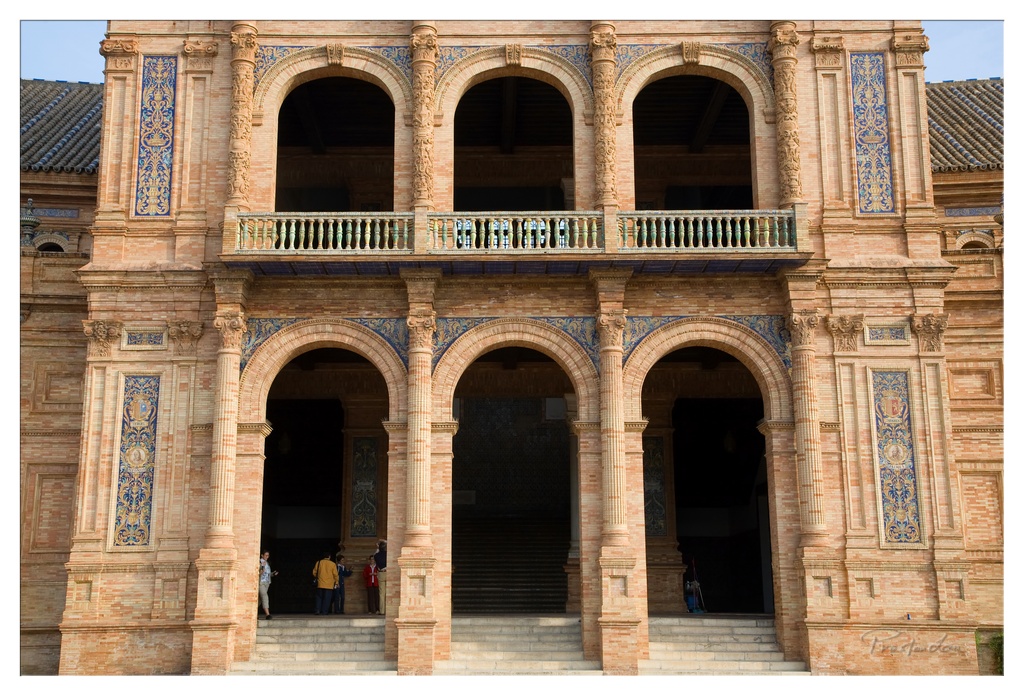

A Grand, Yet Sun-Drenched, Entrance
Rating: 8/10 (Subject: 9/10, Execution: 7/10)
This image presents a majestic view of a multi-story arched facade, likely part of a grand public building, possibly in Spain given the ornate blue and white *azulejo* tiles and the warm-toned brickwork. The architectural style strongly hints at Moorish revival influences, with elegant arches, detailed columns, and intricate tile panels adding bursts of color and pattern against the dominant brick. The composition is very symmetrical, framing three large arches on the ground level leading into a dark interior space, mirrored by three smaller, more open arches on the upper level accessed by a balcony with a decorative railing. A few individuals are scattered near the steps and inside the arches, adding a sense of scale but not truly animating the scene. The overall mood is one of historical grandeur and permanence, albeit slightly muted by the harsh midday sun casting deep shadows that obscure the depth and detail within the arches.
From a photographic perspective, the subject matter – this stunning architecture – is undeniably appealing, earning a high rating. However, the photography itself battles the challenging lighting conditions. The bright sunlight blows out highlights on some surfaces while plunging the shadowed areas under the arches and balcony into near darkness, losing valuable detail and dynamic range. Shooting earlier or later in the day (golden hour!) would have provided softer, more directional light, enhancing texture and revealing the hidden depths. The composition, while classical and symmetrical, is a bit straightforward; perhaps experimenting with slightly off-center framing or focusing on a specific detail like the tiled panels or decorative columns could add more visual interest. Despite the lighting challenge, the photographer has captured the impressive scale and decorative elements of this beautiful building, creating a record of its imposing presence, even if the sun wasn't cooperating. The signature in the bottom right corner marks the artist's claim on this sun-drenched moment.
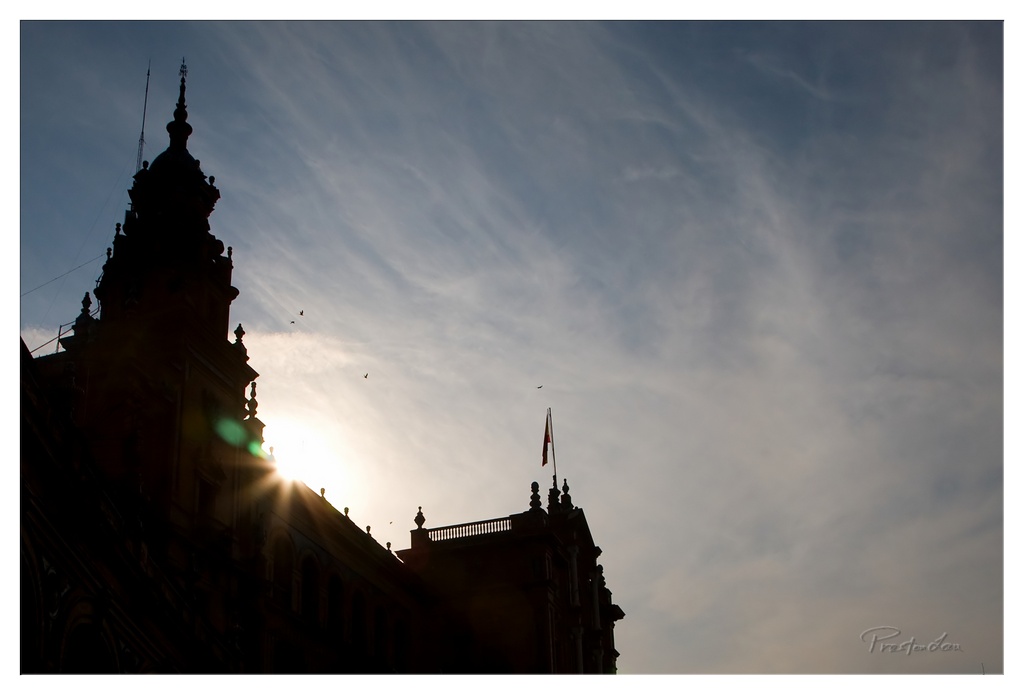

Battle of the Sun and Silhouette
Subject Rating: 7/10 (Intriguing structure, but it's playing hard to get in the shadows)
Welcome to the dramatic showdown between a very proud, very dark building and a blindingly bright sun! Our architectural contestant, seemingly adorned with spires and ornamental bits that are currently incognito, has chosen the 'silhouette' strategy, presenting itself as a stark, mysterious cutout against the sky. Meanwhile, the sun, not one to be subtle, blasts through the scene with powerful backlighting, creating a dazzling (and slightly obnoxious) lens flare that says, "Look at me! No, seriously, look at me!" A few plucky birds are brave enough to cross the firing line of light, adding a touch of dynamic movement to the otherwise static standoff. The sky itself is a beautiful canvas of streaky clouds, like brushstrokes across a pastel blue and white gradient, adding to the ethereal and slightly intense mood of the scene.
From a photographer's standpoint, this is a classic lesson in handling extreme backlighting – expose for the highlights and let the shadows fall where they may, creating a striking silhouette. The composition places the imposing dark mass on the left, leading the eye diagonally towards the lighter, more open sky on the right, with the distant flag adding a small point of vertical interest. The style is clearly focused on capturing the mood and the graphic quality of the silhouette rather than revealing architectural details. The lens flare, while often seen as a flaw, is embraced here to amplify the intensity of the light source, adding character and emphasizing that yes, the sun is *right there*. It's a high-contrast visual poem about light and shadow, and perhaps a reminder to bring a wider brimmed hat next time.
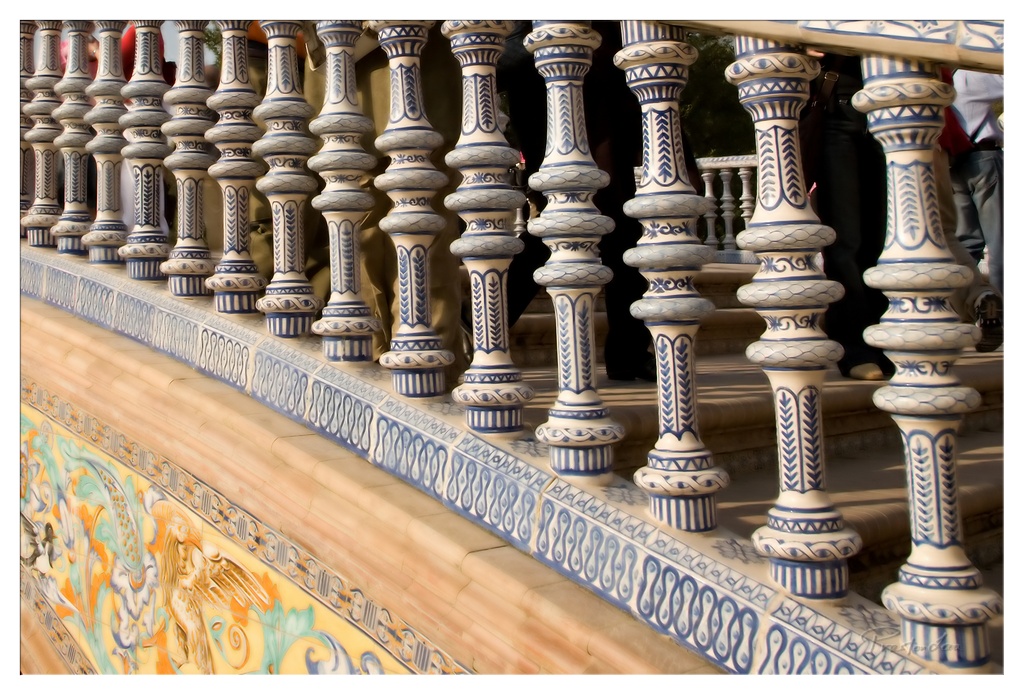

Baluster Extravaganza
Subject Rating: 9/10
Well, hello there, lovely balusters! It seems we've stumbled upon a convention of highly decorated pillars, all lined up and ready for inspection. This shot captures a section of a beautiful railing, likely adorning a grand staircase or balcony, where each ceramic baluster is a little work of art in itself, sporting intricate blue and white patterns that frankly put my plain ol' house railings to shame. Below this parade of pottery, the scene gets even more visually interesting with vibrant, multi-colored decorative tiles featuring flowing patterns and what appears to be a fantastical creature – perhaps a grumpy griffin guarding the steps? In the background, vague shapes of people drift by, blissfully unaware that they are mere supporting actors in this drama of architectural detail. The overall mood is one of elegant, historical richness, suggesting a place where craftsmanship is celebrated.
From a photographer's perspective, this image is a fantastic study in pattern and texture. The composition uses the strong diagonal line of the railing to draw the eye through the repeating forms of the balusters. The low angle emphasizes their height and decorative complexity. Lighting is key here; sunlight hits the foreground, highlighting the glossy glaze of the ceramics and the rich colors of the lower tiles, while the background falls into a soft blur, effectively isolating the main subjects. The contrast between the crisp blues and whites of the balusters and the warmer, earthier tones of the steps and lower tiles adds depth and visual appeal. It’s a great example of finding beauty in repetitive architectural elements and capturing the tactile quality of different materials. Just try not to get dizzy counting all the individual blue squiggles – that's the real challenge!
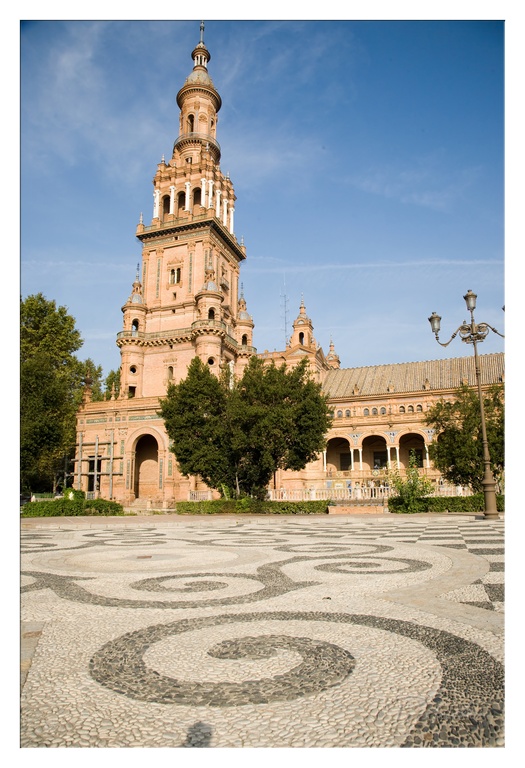

Title: Grand Architecture and Dizzying Designs
Rating: 8/10
Standing proud against a brilliant blue sky is a magnificent, ornate tower and the sprawling facade of a grand building, likely the Plaza de España in Seville. The subject matter gets a solid 8/10 – who can resist such stunning architecture? The mood is one of peaceful grandeur, capturing a moment of quiet magnificence under a clear sky. In the foreground, a mesmerizing plaza paved with cobblestones features bold, dark swirling patterns that seem to draw you into the scene, or perhaps just make you a little dizzy if you stare too long. Lush green trees partially frame the buildings, adding a touch of nature's grace to the structured beauty, while a classic lamppost stands sentinel on the right, looking quite dapper if a bit out of place next to all that history.
From a photography perspective, the composition uses the swirling patterns of the plaza effectively as leading lines, guiding the viewer's eye towards the impressive architecture. Placing the main tower slightly off-center creates a more dynamic shot than a straight-on view, adhering to the rule of thirds for a more pleasing balance. The lighting suggests it's either morning or late afternoon, casting gentle shadows that highlight the textures and details of the building's intricate facade. The color palette is warm and inviting, with the rosy brickwork contrasting beautifully with the cool blues of the sky and the monochrome of the plaza. While the stillness contributes to the calm mood, a tiny part of me wished someone was walking across the plaza, perhaps adding a human element and scale, but then again, no photobombers is a plus for architecture shots! It's a classic architectural landscape capture, showcasing the building's scale and the plaza's unique design effectively.
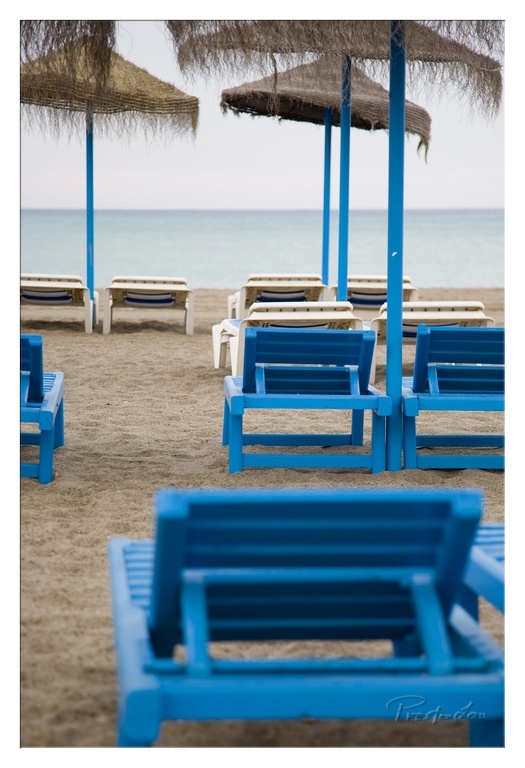

The Waiting Game
Rating: 6.5/10
This image presents a tranquil, somewhat melancholic scene of empty beach chairs and straw umbrellas awaiting occupants, earning a 6.5 out of 10 for its atmospheric portrayal of quietude. The foreground is dominated by several rows of blue plastic chairs and white sunbeds, starkly empty and facing out towards a calm, grey-blue sea that meets an overcast sky. The mood is one of waiting, anticipation, or perhaps the eerie silence after the crowds have departed. It feels less like a vibrant holiday snap and more like a study in form and pattern, highlighting the geometric repetition of the furniture against the natural softness of the sand and water.
Photographically, the vertical composition works well, emphasizing the height of the blue umbrella poles which punctuate the frame and lead the eye into the depth of the scene. The use of a relatively shallow depth of field is noticeable, particularly with the blurred blue chair in the closest foreground, which serves to frame the image and draw focus to the sharper chairs and sunbeds in the middle distance. The soft, diffused light from the overcast sky results in a muted colour palette and a lack of harsh shadows, contributing significantly to the subdued and peaceful (or perhaps slightly lonely) tone. This isn't a shot about sunny days and happy people, but rather about the structure and stillness of a place designed for temporary occupation, captured with a discerning eye for composition and mood.
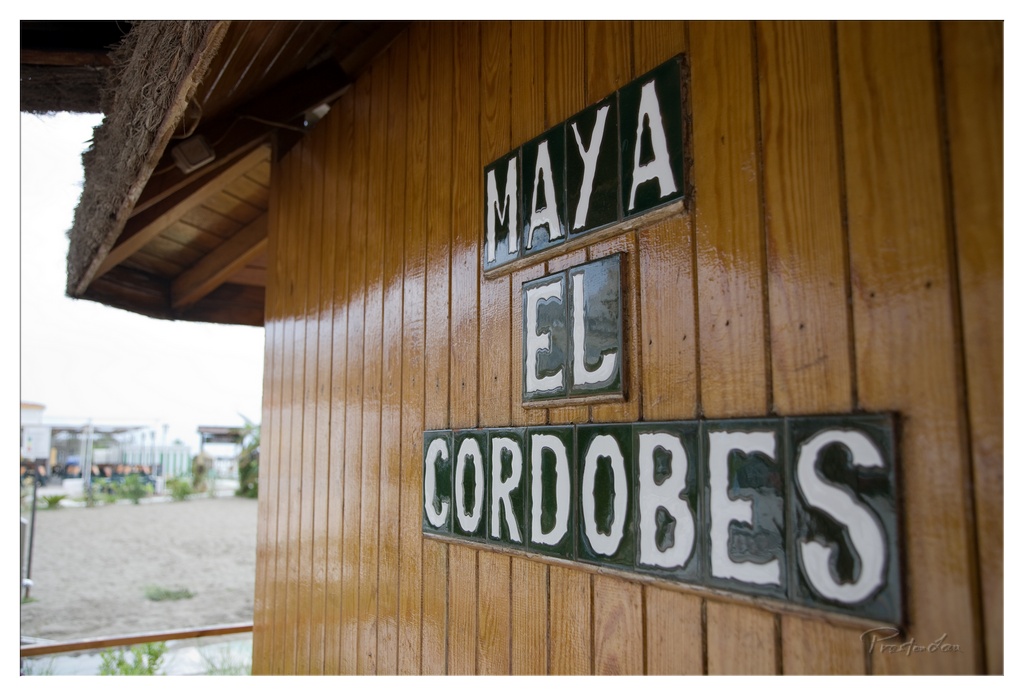

Rustic Signage by the Sea
Subject Rating: 7/10
This image presents a close-up view of a weathered wooden building, likely a seaside establishment given the sandy and slightly blurred beach visible in the background. Prominently displayed on the wall is a name spelled out in dark green and white ceramic tiles: "MAYA EL CORDOBES". The arrangement of the tiles in three rows, with "MAYA" at the top, "EL" in the middle, and "CORDOBES" spanning the bottom, gives the sign a handmade, authentic feel. The rich, varnished wood grain and the edge of a thatched roof add to the rustic charm of the scene. The overall mood is relaxed and informal, suggesting a casual spot by the coast, perhaps a chiringuito or beach bar.
From a photography perspective, the shot utilizes a slightly low angle, directing the viewer's eye up towards the sign and highlighting the textures of the wood and roof. The glossy finish on the wood is particularly noticeable, creating strong reflections that catch the light and add visual interest, albeit potentially challenging for perfect exposure without losing detail in highlights. The composition places the main subject, the sign, slightly to the right, allowing a glimpse of the building's structure and the background on the left, providing context. The use of a relatively shallow depth of field effectively isolates the sign and wall from the distant beach scene, ensuring the viewer's focus remains on the titular "Maya El Cordobes" and their apparently very glossy wall. It's a straightforward capture that leans into the character of the location.
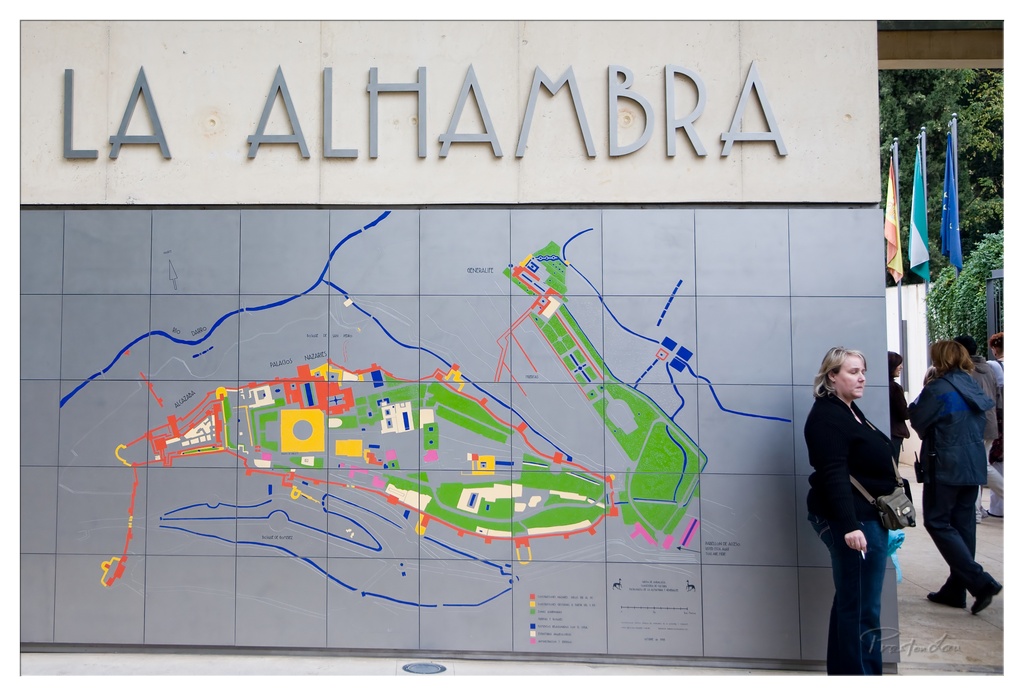

Arrival at the Map of Wonders
Subject Rating: 7/10
Behold, the moment of truth for any intrepid explorer: confronting the gargantuan map that attempts to tame the sprawling complexity of the Alhambra. Here, a woman, perhaps already mentally lost in its intricate lines and colorful zones, stands before the wall-sized guide, clutching a presumably less helpful personal map or just a very determined expression. The imposing "LA ALHAMBRA" lettering above serves as a rather blunt confirmation that she's arrived at the right place, lest she thought this giant map was just a particularly ambitious piece of street art. The mood is one of pre-adventure orientation, a brief pause before diving into the historical labyrinth, surrounded by the implied hum of fellow tourists and the official flutter of flags in the background.
From a photographic standpoint, the composition leans heavily on the large map, making it the dominant visual element. The woman, positioned to the right, provides scale and a narrative focus, though the slightly cropped bottom edge is a minor distraction – did she forget her feet at the last attraction? The lighting is standard outdoor, flat but sufficient to illuminate the details of the map and her contemplative stance. The cool grey of the wall provides a neutral canvas, allowing the vibrant, almost child-like colors of the map's various sections to pop. It's a classic documentary shot capturing a familiar tourist experience, technically sound but lacking dramatic flair. Perhaps a slightly wider shot to include more of the entrance or a different angle that emphasizes the sheer scale of the wall and map would have elevated it, but as is, it effectively conveys the necessary moment of "Okay, where exactly am I going?"
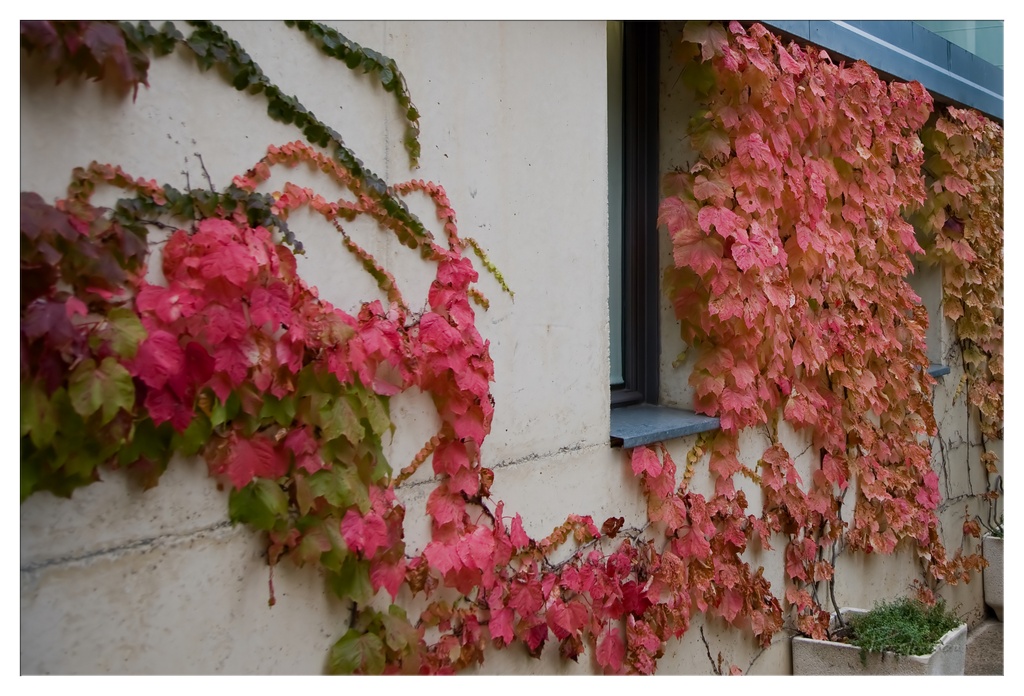

Autumn's Crimson Cloak
Subject Rating: 8/10
In this vibrant autumn scene, a wall serves as the canvas for a dramatic display of nature's artistry, courtesy of some rather ambitious ivy. The subject is clearly the striking transition of the ivy leaves from verdant green to intense shades of crimson, pink, and orange as they cling tenaciously to the textured beige surface. It looks like the vine is staging a full-scale takeover, creeping relentlessly upwards and sideways, completely blanketing a section of the wall and framing a dark window with its colorful foliage. The mood is decidedly autumnal – a celebration of rich, fleeting color set against the permanent structure of the building. It's a snapshot of the seasonal change, where the organic world makes a brief, fiery statement before winter sets in.
From a photographer's perspective, this shot makes great use of color and texture. The composition uses the natural lines of the climbing vines to lead the eye across the frame, although it's quite busy, which is typical when photographing dense foliage like this. The soft, diffuse lighting is a clever choice; it avoids harsh shadows and really allows the saturated red and pink hues to pop against the neutral wall. It's a good example of finding beauty in everyday scenes, even if those scenes involve plants attempting a full-scale arboreal invasion of private property. The window adds a touch of context and depth, preventing the image from being just a flat wall of leaves, reminding us that this natural spectacle is happening on a man-made structure. The subtle details of the wall texture and the faint green in the pot below add to the overall realism and charm of this seasonal portrait.
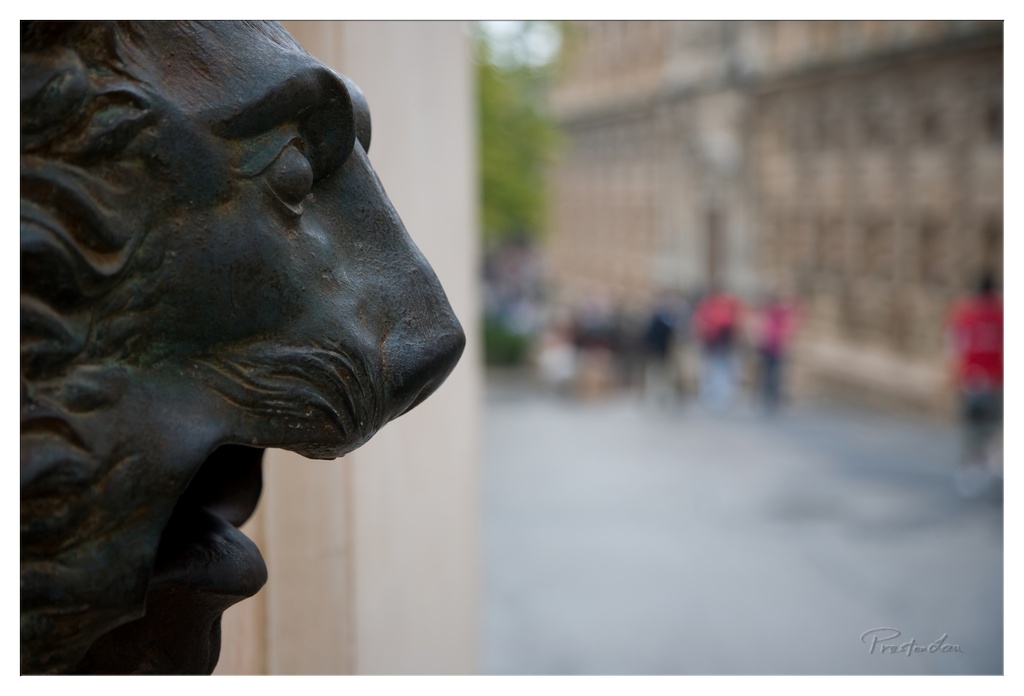

Guardian of the Bokeh
Subject Rating: 8/10
Ah, the majestic, slightly annoyed-looking lion head. This bronze beauty is clearly the star, rated a solid 8/10 for its dramatic profile and intricate mane details. What's happening? Not much, if you're the lion. It's eternally frozen mid-growl or perhaps just yawning, contemplating the blurry existence of the humans milling about in the background. The composition is classic, placing the main subject prominently on the left, allowing its stern visage to dominate the frame. This forces the viewer's eye directly to the detailed, sharp texture of the sculpture, a stark contrast to the dreamy, buttery bokeh that swallows the rest of the scene. It's like the photographer is saying, "Look at this awesome lion! Everything else? Meh, who cares." The style screams shallow depth of field, isolating the subject with a vengeance, turning people and buildings into abstract smudges of color and light.
The mood feels a bit stoic and historic, fitting for a potentially ancient architectural element, yet juxtaposed with the fleeting, anonymous nature of the blurred background figures. The lighting seems soft, perhaps overcast, which works well to prevent harsh shadows on the detailed metalwork, bringing out the greenish patina. The color palette is muted, focusing on the deep greens and browns of the lion against the soft, warm tones of the building and the cooler greys of the street. From a photography perspective, this shot is a masterclass in selective focus, expertly guiding attention. The humorous element comes from the idea of this ancient, imposing figure being completely indifferent to the modern hustle and bustle dissolving behind it – they're literally just noise in the background, irrelevant to the lion's stony dignity. It's a great example of using aperture creatively to simplify a busy scene and highlight the subject.
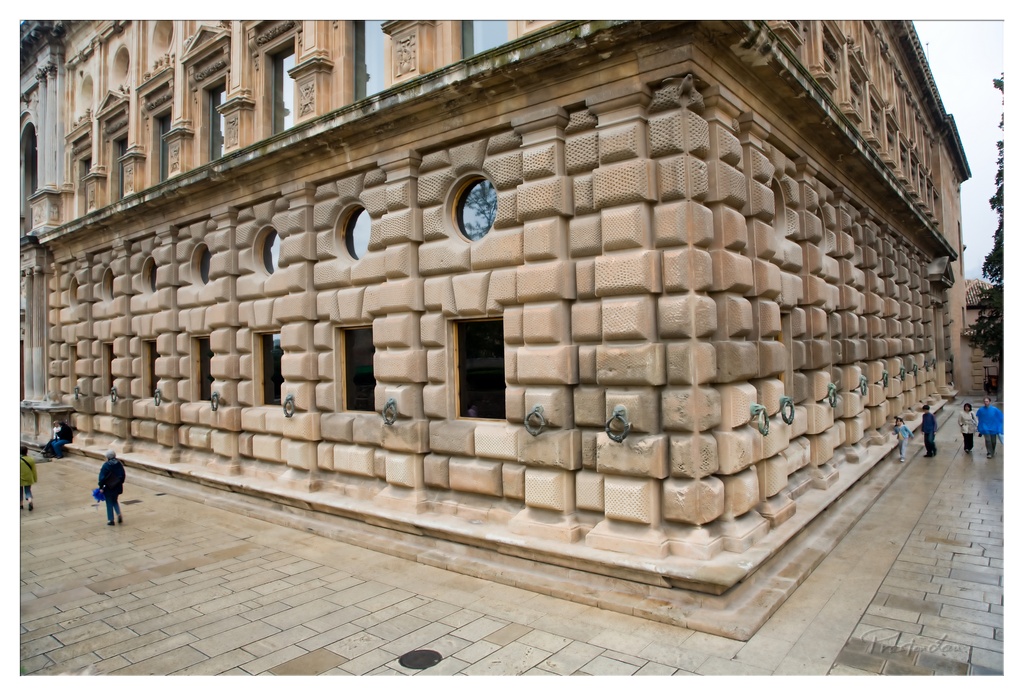

Palace of Unyielding Cubes
Subject Rating: 8/10
This image captures the imposing corner of what appears to be the Palace of Charles V within the Alhambra complex. What's happening is primarily a display of architectural might, specifically the intense rustication of the ground floor, making the building look like it's constructed from oversized LEGO bricks designed by a Brutalist stonemason. A few dwarfed figures amble along the damp-looking pavement, providing scale and a fleeting sense of human activity against the monumental backdrop. The mood leans towards grand and historic, but the overcast sky lends a slightly somber, muted tone, like the weather couldn't quite decide if it was impressed or just tired. You can almost hear the stones groaning under their own weight, or maybe that's just the photographer's back after tilting the camera up. Notice the peculiar rings embedded in the wall – perhaps historical parking spots for very large, very patient horses?
From a photographic perspective, the composition is solid, employing a low angle and a corner view to emphasize the building's mass and depth. The repetitive pattern of the rusticated stones creates a strong visual rhythm, though the flat, overcast lighting does little to enhance this incredible texture. Direct sunlight hitting this facade would create dramatic shadows, really making those 'diamond points' pop – currently, they feel a bit flattened, like someone ironed the building. The color palette is appropriately earthy and muted, reflecting the stone and the cloudy conditions. While the lighting isn't ideal for showcasing texture, it does provide soft, even illumination across the entire scene, avoiding harsh highlights or deep shadows, which is useful for documentary purposes, even if it lacks a certain 'wow' factor. Capturing such a massive structure requires a good sense of perspective and line, and this shot nails the scale, reminding us just how insignificant we are next to architectural history built with giant, textured blocks.
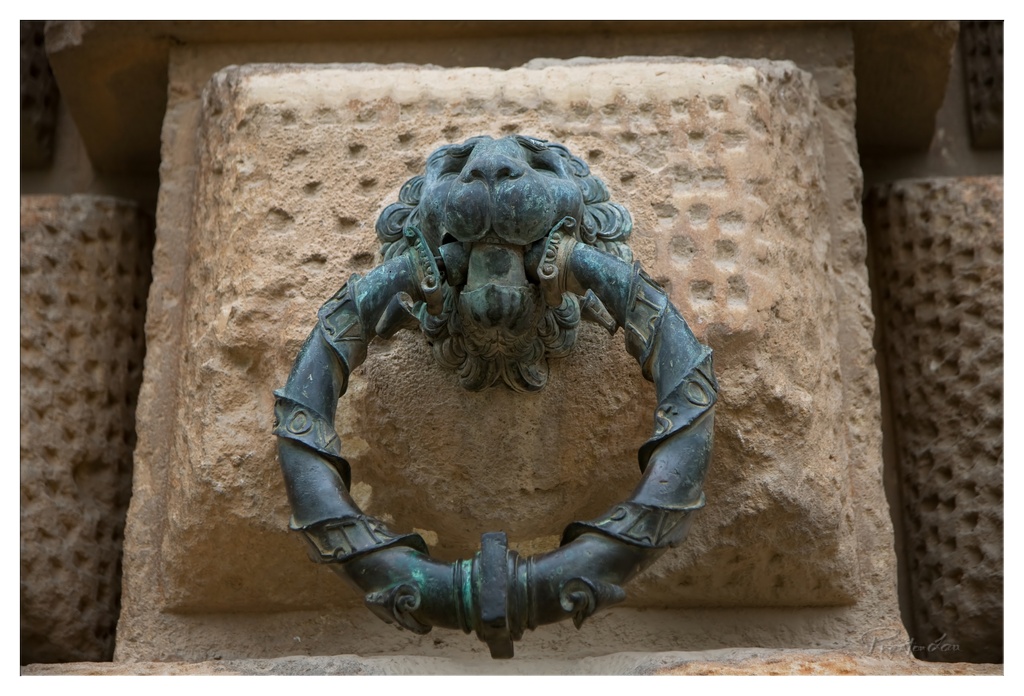

Ancient Sentinel
Subject Rating: 9/10
Here we have a truly regal subject – a weathered bronze door knocker shaped like a fearsome lion's head, looking less than amused by the prospect of someone disturbing its stony slumber. Mounted firmly on a rough-hewn stone block, this is the ultimate silent gatekeeper, daring you to make some noise. The lion's mane is intricately detailed, almost flowing like waves, and its expression is a masterful blend of ferocity and stony patience. The large, twisted ring held in its mouth adds a touch of ancient grandeur, hinting at stories and secrets behind the door it guards. The mood is decidedly historical and a little imposing, like standing before the entrance to a forgotten castle or a very serious tax office.
From a photography perspective, this is a stellar close-up study. The composition is dead center, giving the subject undeniable presence, which is effective here given the detail. The lighting is fantastic, catching the texture of both the metal and the stone, creating dramatic highlights and shadows that emphasize the relief and age of the piece. Notice how the verdigris patina on the bronze is beautifully rendered against the warm, earthy tones of the stone. The focus is pin-sharp on the knocker, making sure every twist of the ring and furrow on the lion's brow is visible, inviting the viewer to appreciate the craftsmanship. It’s a great example of how to make an everyday object feel monumental and steeped in history through careful framing and lighting.
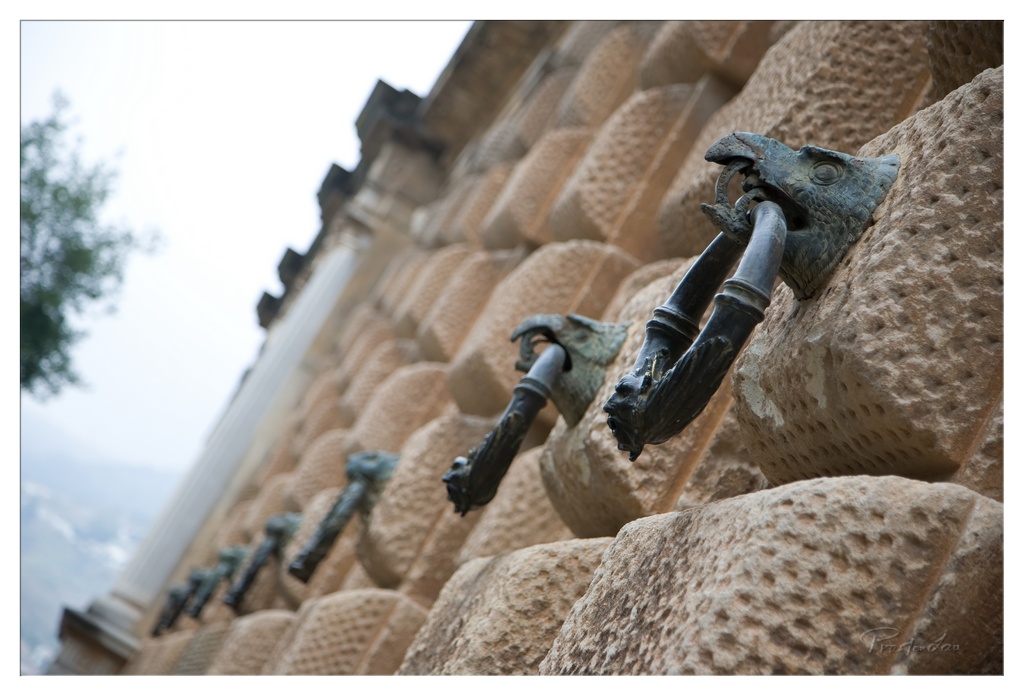

Stone Guardians of the Wall
Subject Rating: 8/10
Here we see a close-up detail of an ancient wall, seemingly part of a grand building or fortification, where fierce-looking metal animal heads, possibly eagles or some form of mythical griffin, are mounted into the massive, rough-hewn stone blocks. Each head grips a heavy metal ring in its beak or mouth, giving the impression they are either holding the rings or perhaps these were once part of a drainage system, spewing water like aggressive gargoyles, though currently they appear dormant and purely decorative. The repetitive pattern of these stoic guardians marches diagonally across the frame, creating a sense of rhythm and depth, while the closest head is sharply in focus, inviting the viewer to examine its intricate, slightly menacing details. The overall mood is one of historical gravitas, hinting at the age and imposing nature of the structure, under a bright, perhaps overcast sky.
From a photographic standpoint, this shot uses a clever diagonal composition, leading the eye along the line of the wall and fixtures and adding a dynamic feel to what is a static subject. The shallow depth of field is expertly employed to isolate the primary subject – the nearest metal head – allowing the viewer to appreciate its texture and form while the other elements soften into a pleasing blur, effectively separating the detail from the expansive wall behind it. The lighting is soft and even, which is perfect for highlighting the rough, pitted texture of the stone blocks and the aged patina of the metal, without harsh shadows distracting from the details. It's a great example of focusing on an interesting architectural element that might otherwise be overlooked in a wider shot, giving it the prominence it deserves, even if these metal heads look like they're contemplating biting your hand off if you get too close.
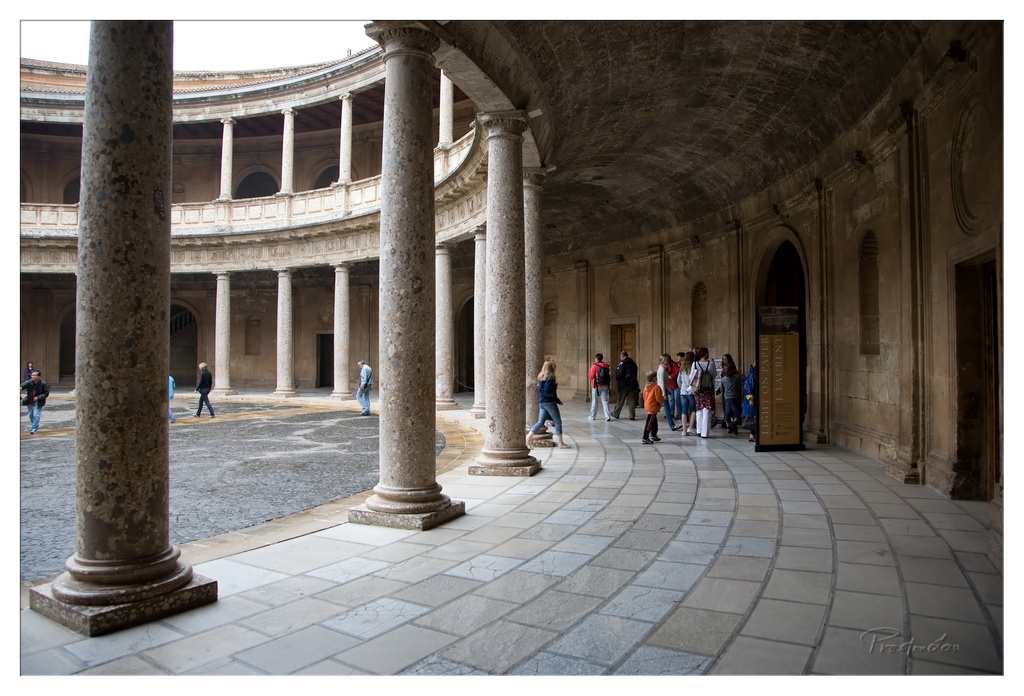

A Grand Entrance to Ancient Columns
Subject Rating: 8/10
Welcome to the Palatial Pancake, or perhaps it's the Emperor's Rotunda? Whatever this magnificent circular structure is called, it's certainly a feast for the eyes, if not a slightly confusing navigational challenge. People are milling about, doing what tourists do best – admiring the architecture, checking their maps, and probably wondering if there's a gift shop selling mini columns. The mood is one of quiet awe mixed with the gentle hum of human activity, like a classical music piece slightly off-key with shuffling feet. You can almost hear the echoes of history bouncing off the stone, punctuated by someone asking, "Are we nearly there yet?"
From a photographic standpoint, this shot masterfully uses the foreground columns to frame the scene, drawing your eye into the depths of the rotunda. The composition creates a sense of scale and perspective, though the slightly off-centre placement of the nearest left column feels like it's leaning in to whisper secrets. The lighting is natural and soft, highlighting the texture of the aged stone and creating gentle shadows that define the curves of the building. The color palette is predominantly earthy and muted, reflecting the ancient nature of the structure, with pops of color from the visitors' clothing providing a modern contrast. It's a classic architectural shot, capturing the grandeur and repetitive rhythm of the columns, proving that sometimes, the best subjects are just big, circular buildings filled with history and casual sightseers.
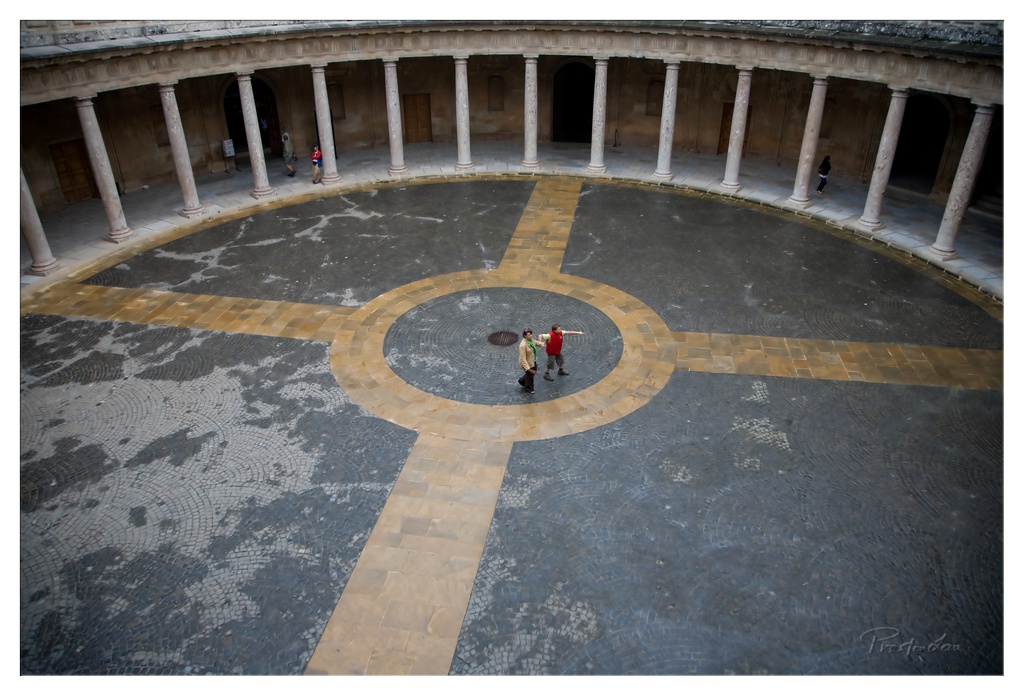

Courtyard Command Center
Subject Rating: 8/10
Welcome to the "What direction do we go now?" plaza! Our intrepid subjects stand at the very nexus of this rather impressive circular courtyard, forming a human compass on the striking geometric paving. One gentleman, clearly the appointed navigator, is giving a dramatic horizontal point, perhaps indicating the location of the nearest ice cream stand or the exit route lest they be trapped forever by the perfectly aligned columns. Meanwhile, others mill about under the elegant colonnade, enjoying the shade or perhaps trying to avoid being added to the central tableau. The overall mood is one of quiet historical grandeur mixed with the subtle chaos of human exploration, proving that even in magnificent architectural spaces, the age-old question remains: "Are we there yet?"
From a photography perspective, this high-angle shot does a fantastic job of highlighting the stunning circular and linear patterns of the paving, transforming the ground into a work of art itself. The slightly overcast lighting is a double-edged sword – it keeps the shadows soft and even, which is great for showing detail on the pavement, but it also leaves the stone columns looking a little flat and the scene lacking a bit of dramatic punch. The muted color palette emphasizes the textures of the stone, but the pops of red and green from the central figures are essential for drawing the eye and adding a sense of scale to this vast space. It's a solid composition that uses the architectural elements to frame the central human interest, even if they do look a little like ants from this perspective. A touch more contrast or perhaps shooting at a slightly different angle to catch some raking light on the pavement might have elevated it, but overall, it successfully captures the impressive scale and design of the courtyard.
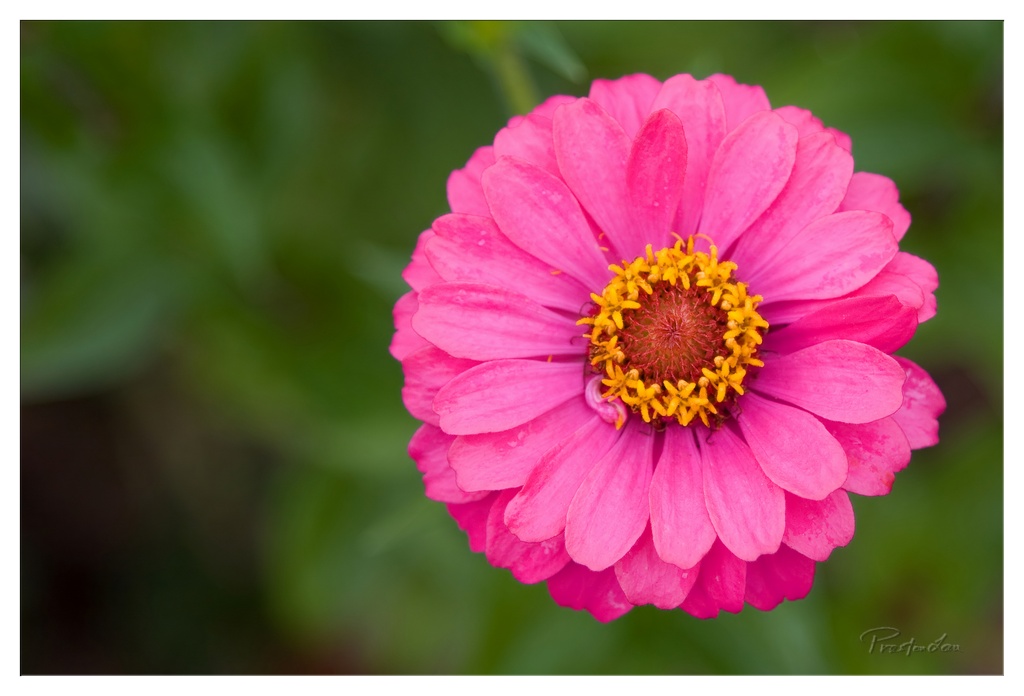

Petal Power Portrait
Rating: 9/10 (For sheer floral audacity!)
Behold, the mighty pink zinnia, posing like it owns the place (which, in the context of this photo, it absolutely does). What's happening? Well, this fabulous bloom is simply existing, soaking up some soft light, and showing off its impressive array of neatly arranged pink petals and a cheerfully messy, golden-yellow center. The mood is one of serene, vibrant nature – the kind of calm you feel right before remembering you have to water the rest of the garden. This is a classic close-up floral portrait, emphasizing the beauty and texture of the subject against a delightfully blurred backdrop. The subject matter is undeniably beautiful, earning a high score for being a star. The pertinent object is, of course, the star-of-the-show pink flower itself, complete with glistening dew or water droplets on some petals. The background is a soft, dreamy swirl of muted greens, providing just enough context of a leafy environment without distracting from the main event.
From a photography perspective, this shot nails several key elements. The composition places the flower slightly off-center, leaning into a more dynamic view than a straight-on shot, hinting at the rule of thirds without being rigidly placed. The lighting is soft and even, beautifully illuminating the petals and highlighting the textures in the center without harsh shadows – likely captured on an overcast day or in open shade, a photographer's favorite for floral portraits. The color is a major win here; the saturated pink is punchy and vibrant against the complementary, desaturated green background, making the flower pop with delightful intensity. The focus is spot-on, with the center and front petals sharp, while the background melts away into a creamy bokeh, isolating the subject effectively. The style is clean and focused, letting the natural beauty of the flower be the sole subject, right down to the subtle signature adding a personal touch. It's a well-executed, cheerful piece that makes you appreciate the simple beauty of a garden bloom.
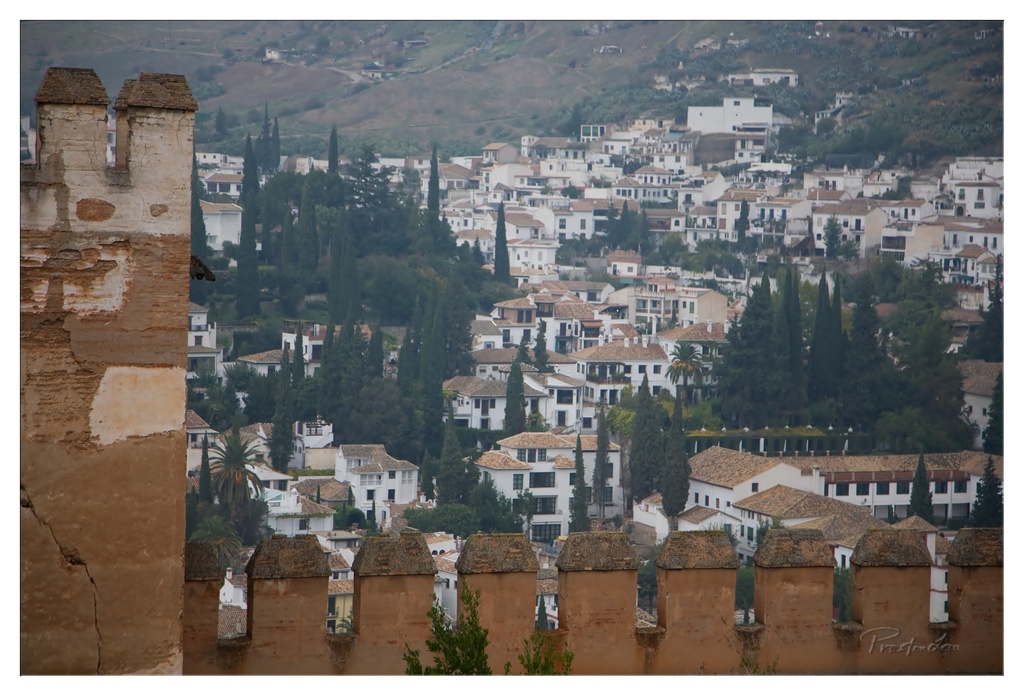

View from the Alhambra Wall
Rating: 8/10
This image presents a classic view, likely from the historic walls of the Alhambra in Granada, Spain, looking out over the city nestled on the hillside. The mood is one of quiet observation and timelessness, capturing the juxtaposition of ancient fortifications and the sprawling, white-washed city below. The dominant foreground element is the textured, aged stone wall with its battlements, which acts as a strong, slightly imposing frame for the scene beyond. Behind the wall, the city cascades down the hill, a tapestry of white buildings with terracotta roofs, interspersed with the dark green spires of cypress trees, creating a sense of depth and verticality leading towards the hazy hills in the distance under a soft, overcast sky.
From a photography perspective, the composition makes a bold statement by placing the wall so prominently in the foreground and left side. While it effectively grounds the viewer within the historical context of the vantage point, the sheer mass of the wall slightly competes with the cityscape for attention. The soft, diffuse lighting typical of an overcast day eliminates harsh shadows but results in a somewhat flat, muted color palette dominated by earthy tones and desaturated greens. This soft light does, however, enhance the historical mood. The focus appears to be primarily on the mid-ground city, leaving the immediate foreground wall slightly softer, which helps to emphasize the distant view but might frustrate those who prefer sharp detail throughout the frame. Overall, it's a well-composed shot that captures the essence of the location, though a bit more contrast or vibrancy could lift the image.
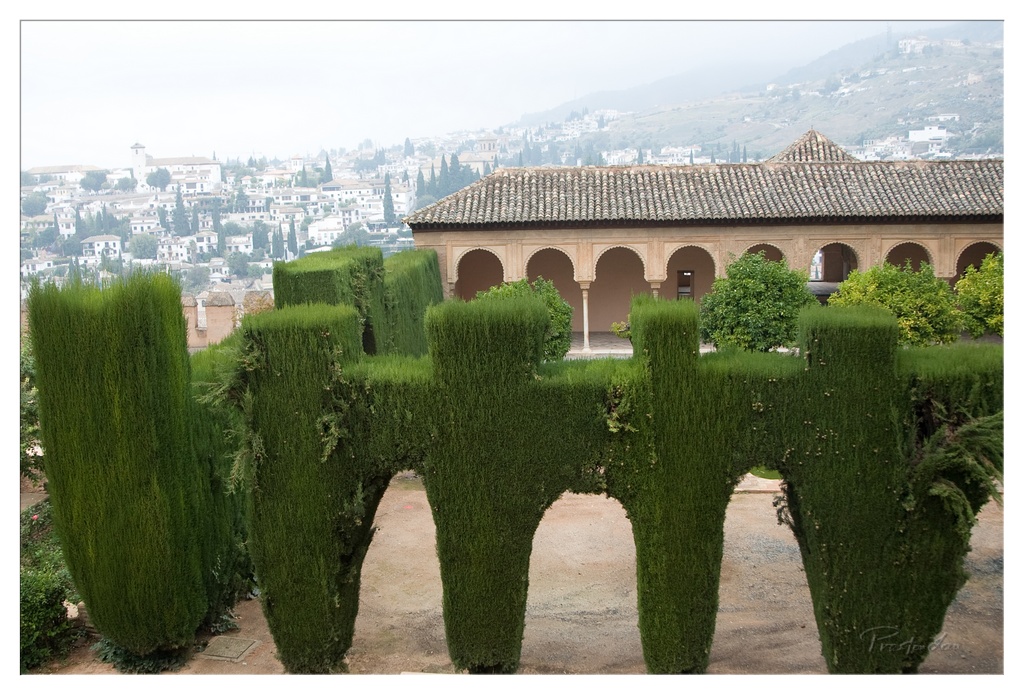

Title: Guardians of the Alhambra Garden
Rating: 7/10
Step right up and meet the incredibly disciplined topiary army defending the view! This image captures a section of the stunning Alhambra gardens, where meticulously sculpted hedges stand tall and proud, forming a striking, formal foreground. They create a series of dark green walls and archways, almost acting like giant, leafy bouncers controlling access to the beauty beyond. Behind this botanical fortress sits a charming building with elegant arches and a classic tiled roof, part of the palace complex, offering a glimpse of exquisite architecture. In the distance, the city of Granada spills down the hillsides, a sea of white buildings under a blanket of soft haze. The mood is serene and historic, a blend of human design and natural beauty, though one wonders if the hedges are secretly planning a geometric revolution.
From a photographer's perspective, the composition is heavily weighted towards the foreground by these substantial hedges, which provide interesting shapes and textures but also block a good chunk of the middle ground. The light is typically overcast and diffuse, perfect for avoiding harsh shadows but rendering the scene somewhat flat and contributing significantly to the hazy background, making the city look a bit like a faint dream. The color palette is dominated by the rich greens of the foliage and the warm, earthy tones of the stone building, all slightly muted by the soft light. While the location is undeniably picturesque, the lighting conditions make it a technical challenge, resulting in a pleasant but not particularly dynamic image. Plus, there's a photographer's signature trying to hide in the corner, a little bit of ego creeping into the otherwise tranquil scene.
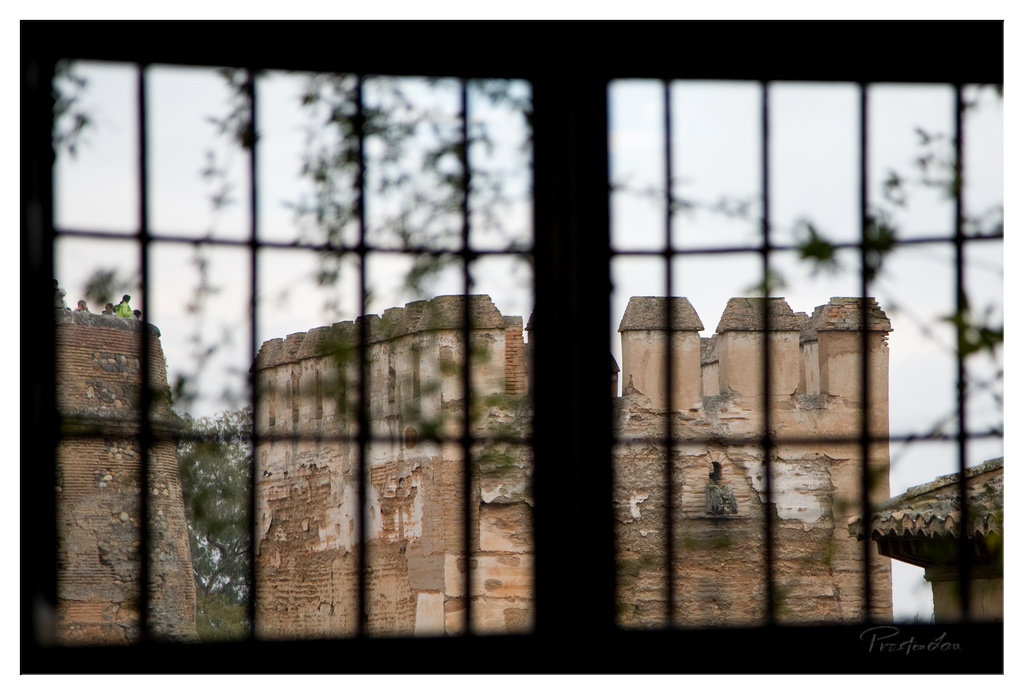

Through the Lattice of Time
Subject Rating: 8/10
This image offers a glimpse of ancient architecture framed by a rather imposing set of window bars. It's like the photographer is either locked in or just really committed to that "looking through a grate" aesthetic. The primary subject is a section of a weathered stone and brick fortress wall, complete with crenellated battlements and sturdy towers, looking suitably worn and full of stories. In the distance, on the left tower, you can just make out a few small figures, presumably modern-day visitors or perhaps extremely dedicated historical reenactors who forgot their costumes. The scene is viewed from a perspective that places the viewer firmly behind the dark, silhouetted grid of the window, creating a strong sense of separation between the observer and the observed.
Compositionally, the heavy framing by the bars dominates the image, breaking the view into segments, which is a bold choice that certainly emphasizes the feeling of looking *through* something. The depth of field is shallow enough to blur the bars and some foreground leaves, ensuring the eye is drawn to the detailed texture and form of the ancient wall behind them. The lighting appears soft and diffused, casting no harsh shadows and contributing to a somewhat muted, historical tone. The color palette is dominated by earthy browns, greys, and faded terracotta, appropriate for the aged stone and brick. While the bars add a unique visual element, they also make the shot feel a little claustrophobic, as if the history is just out of reach, or perhaps being protected (or imprisoned?) by the modern barrier. It's a thought-provoking perspective, even if it makes you wonder if the photographer was scouting locations for a prison break movie.
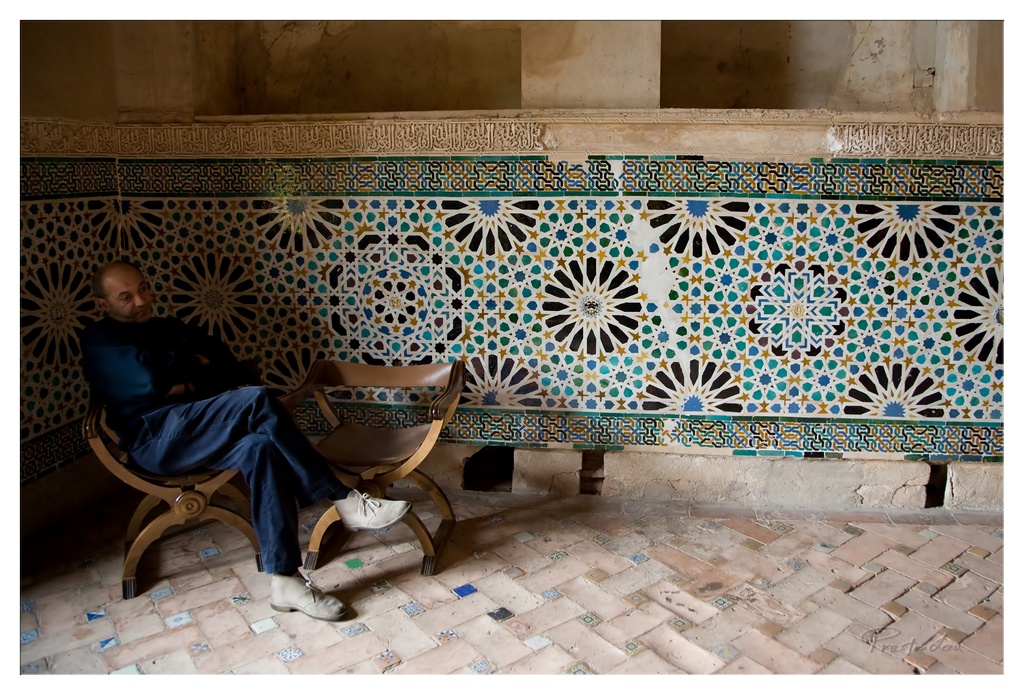

A Moment of Contemplation (or Perhaps Just Waiting for Lunch)
Subject Rating: 7/10 (The man is interesting, but the tiles steal the show!)
Alright, let's be honest, this gentleman is putting in a valiant effort, sitting so calmly on his fancy curved wooden chair amidst this explosion of geometric perfection. He's got the relaxed pose down pat – arms crossed, one leg extended, wearing what appear to be quite comfortable light-colored boots – and he seems to be deep in thought, or perhaps just mildly bored. You can almost hear him thinking, "Yes, yes, the tiles are lovely, but is there a coffee shop nearby?" His dark blue sweater and trousers provide a nice solid block of color against the busy background, a little island of human stillness in a sea of repeating patterns. The setting is clearly historical and rather grand, judging by the intricate mosaic tiles covering the wall, the decorative band of what looks like carved calligraphy above, and the rustic brick floor.
From a photographic perspective, this shot uses the incredible architectural detail to its advantage, creating a visually rich backdrop for the human subject. The composition places the man slightly off-center, allowing the vast expanse of the wall to dominate the frame, which is probably fair given its beauty. The strong horizontal lines of the tile patterns and the floor provide a solid structure, while the intricate details draw the eye in. The lighting seems to be natural, coming from the right, casting pleasant shadows that define the textures of the floor and the man's clothing, although the shadows on his face are a little deep. The color palette is fantastic, with the warm earthy tones of the floor and upper wall contrasting wonderfully with the cool, vibrant blues, greens, and pops of yellow and black in the tiles. It's a great example of how a human presence can add context and scale to an impressive architectural scene, turning a static shot of a wall into a moment in time.
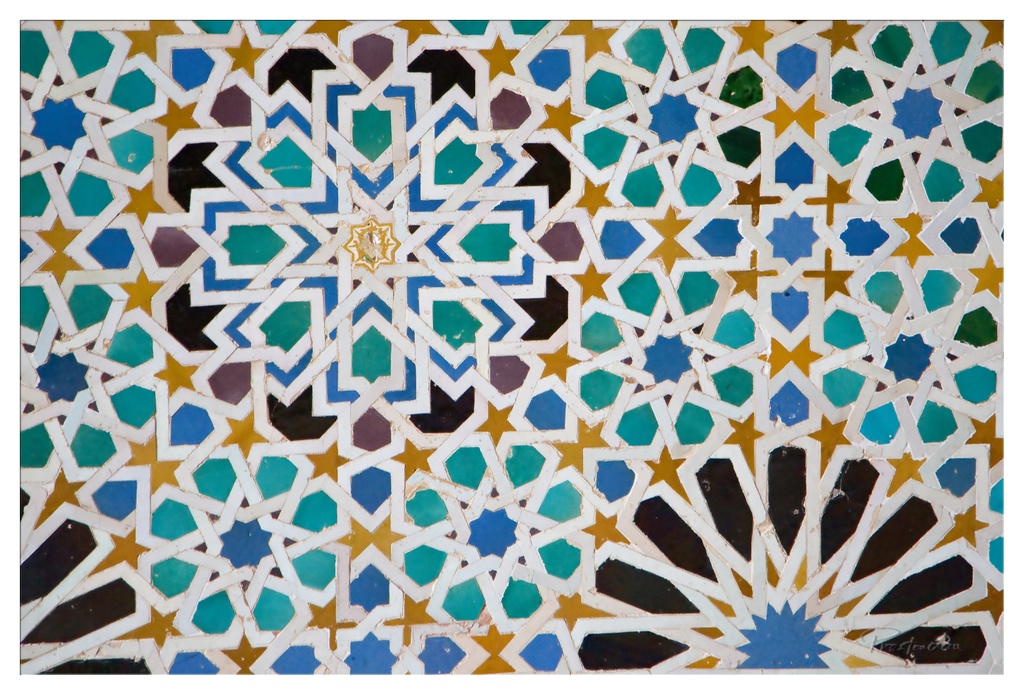

A Geometric Masterpiece
Rating: 8/10
This image presents a stunning close-up of intricate Islamic geometric tilework, a truly mesmerizing subject rated an 8 out of 10 for its sheer complexity and artistry. Nothing is 'happening' in the dynamic sense; instead, we are invited to quietly admire a static display of mathematical precision and artistic dedication frozen in time on a wall. The mood is one of intricate beauty, deep history, and almost overwhelming detail, evoking a sense of wonder at the craftsmanship involved. This style is quintessential Islamic geometric art, relying on repeating patterns of stars, polygons, and interwoven lines to create a visually dense and harmonious surface, often found in mosques, palaces, and other significant buildings across the Islamic world. The sheer number of individual tiles and the complexity of their arrangement make this a fascinating subject to behold.
From a photography perspective, the execution is solid for documenting such a detailed surface. The composition fills the frame, allowing us to fully immerse ourselves in the pattern, capturing both the central repeating motif and a glimpse of a different radial design at the bottom right, where a small signature is also visible. The lighting appears wonderfully flat and even across the surface, a crucial choice here as it minimizes glare and harsh shadows, allowing the textures of the tiles and grout, as well as the vibrant blues, teals, yellows, and touches of purple and black, to come through clearly. Capturing such a busy pattern without distortion or distracting highlights is no small feat, and the photographer has succeeded in presenting this complex subject matter with clarity and respect for its inherent beauty. It makes you appreciate the patience required not just to create the tiles, but also to photograph them without missing a single piece of the puzzle – unlike my attempts to piece together flat-pack furniture instructions, this seems achievable with precision and a good camera setup.
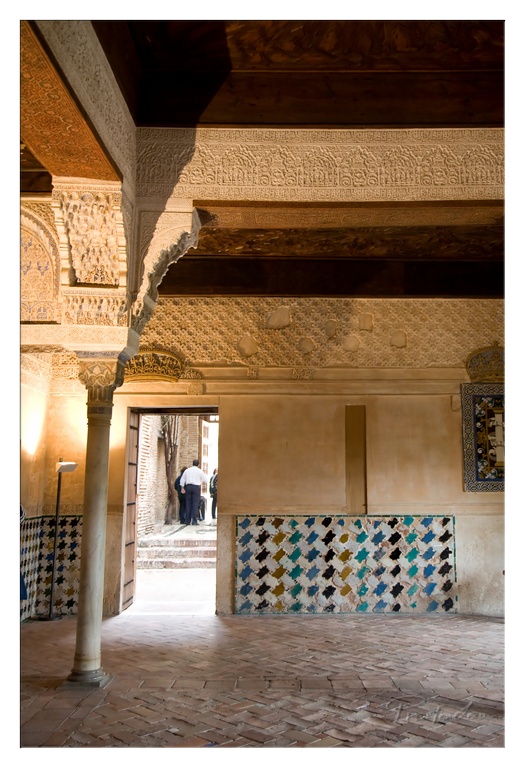

Ancient Opulence and Modern Intruders
Rating: 9/10
Welcome to what appears to be a stunning example of historical architecture, likely from the Alhambra or a similar Moorish palace, a solid 9/10 on the sheer 'wow factor' scale for subject matter alone. The scene captures a moment within an ornately decorated interior chamber, where intricate plasterwork adorns arched doorways and beams, leading the eye towards a sunlit exterior path. In the background, a couple of figures, presumably modern-day explorers (or perhaps just lost tourists looking for the nearest gelato stand), are making their way through an archway, providing a sense of scale and perhaps slightly breaking the ancient spell with their casual attire. The mood is one of serene, slightly worn grandeur, a silent testament to centuries of history, punctuated only by the distant footsteps of the present.
From a photographer's perspective, this shot is a masterclass in capturing texture and depth, despite the challenging lighting conditions. The composition is strong, using the prominent column and the archway as natural frames that draw the viewer into the background scene. The tiled wall panel in the foreground adds a vibrant splash of color and geometric pattern, a beautiful counterpoint to the organic, flowing motifs of the carved plaster above. The low angle emphasizes the height and decorative detail of the structure overhead. However, the contrast between the relatively dark interior and the bright exterior creates a significant dynamic range challenge – you can almost hear the camera sensor groaning under the strain. While the harsh sunlight effectively highlights the intricate carvings, it also creates deep, potentially detail-crushing shadows, giving the scene a dramatic, almost theatrical quality. It’s a tricky balance, but the resulting image successfully conveys the atmosphere of this magnificent, layered space, even if those folks in the background are slightly less impressive than the 800-year-old walls.
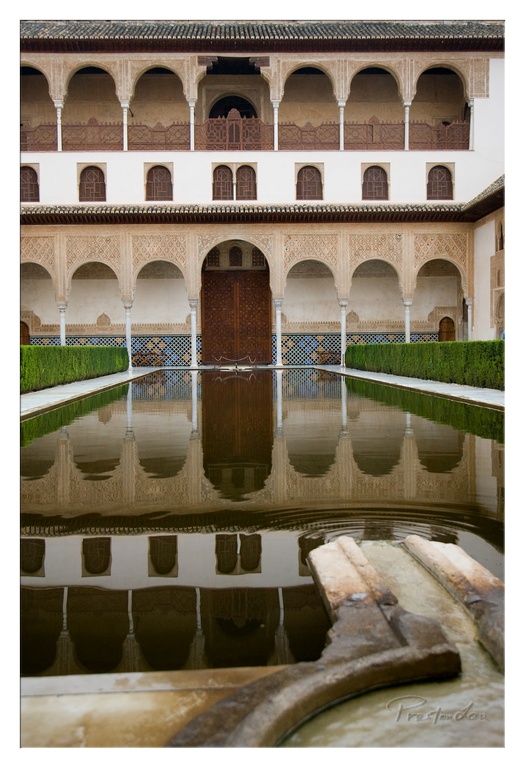

Alhambra Reflection with Foreground Splash
Rating: 9/10 for Subject Matter
Behold the serene majesty of the Alhambra's famous Court of the Myrtles, captured in a moment of near-perfect stillness. The subject, a truly iconic piece of Moorish architecture, stands tall and proud, its intricate arches, detailed carvings, and multi-tiered facade beautifully reflected in the long, tranquil pool that dominates the central courtyard. Lush green hedges line the water's edge, adding a vibrant touch to the warm, earthy tones of the building, while the cool blues and whites of the tiled base provide a striking contrast. The grand, imposing door in the center serves as a focal point, its reflection a mirror image inviting us deeper into the scene. The mood is overwhelmingly peaceful and grand, transporting you back centuries. It's a classic architectural and reflection shot, demanding both patience for the perfect conditions and a keen eye for composition.
From a photographer's perspective, this shot nails the symmetry, leveraging the reflective pool to double the visual impact of the stunning architecture. The vertical framing accentuates the height of the building and the depth of the reflection. The lighting appears soft and diffused, avoiding harsh shadows and allowing the intricate details of the carvings to be clearly seen on both the building and its watery doppelganger. The color palette is rich yet harmonious. However, the inclusion of the fountain element in the immediate foreground, while adding a layer of depth and texture with its rippling water and rough stone, does slightly disrupt the otherwise pristine reflection in that area. It's a creative choice – perhaps intended to add a sense of life and dynamism – but it means the bottom section isn't as clean a mirror as the rest. Still, capturing such a clear reflection in a busy spot takes skill, or perhaps just getting there before the tourist tsunami arrives to stir the waters! A solid example of classic travel photography.
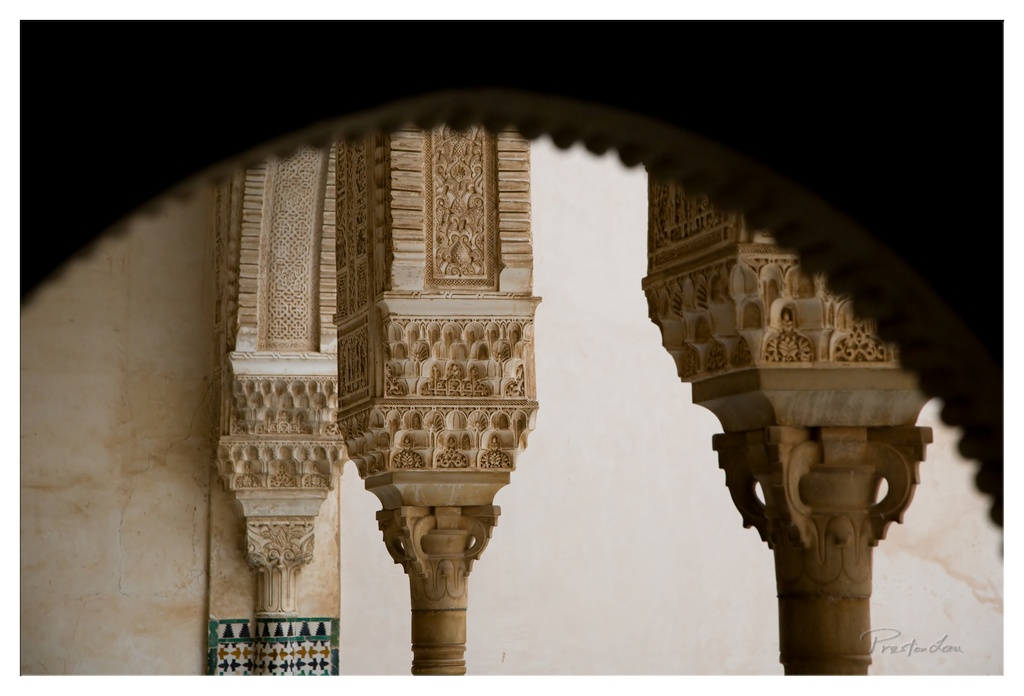

Alhambra Column Convention
Rating: 8/10
Well, hello there, peek-a-boo columns! It looks like we've stumbled upon a rather exclusive gathering of highly decorative pillars, perhaps discussing the latest in intricate carving techniques or complaining about pigeon-related incidents. The subject matter here is definitely a showstopper – three stunningly ornate columns, each vying for the title of 'Most Fabulous Foliage and Geometric Pattern' while standing stoically against a plain backdrop. The mood is one of ancient grandeur and quiet contemplation, like you're peeking into a forgotten corner of history, maybe even interrupting a column gossip session. The detail on these things is mind-boggling; you could get lost for days tracing those patterns, making you wonder if the builders had serious carpal tunnel or just an extreme aversion to plain surfaces.
From a photographic perspective, the composition uses a rather dramatic framing device – a dark, blurry archway in the foreground, acting like a keyhole into this world of architectural beauty. While it adds a sense of intrigue, it does feel a *little* like the arch is trying to hog the spotlight with its jagged edge, distractingly close to the camera. The lighting is soft and diffused, beautifully highlighting the textures and depth of the carvings without harsh shadows – clearly, these columns are lit by photographers who know their angles. The color palette is muted and earthy, dominated by the warm stone tones, though the splash of green and blue tiles at the base of the leftmost column provides a welcome little pop of color, like a subtle historical accessory. It's a solid shot that showcases the incredible craftsmanship, although maybe next time tell the arch to back up a bit and let the stars of the show truly shine.
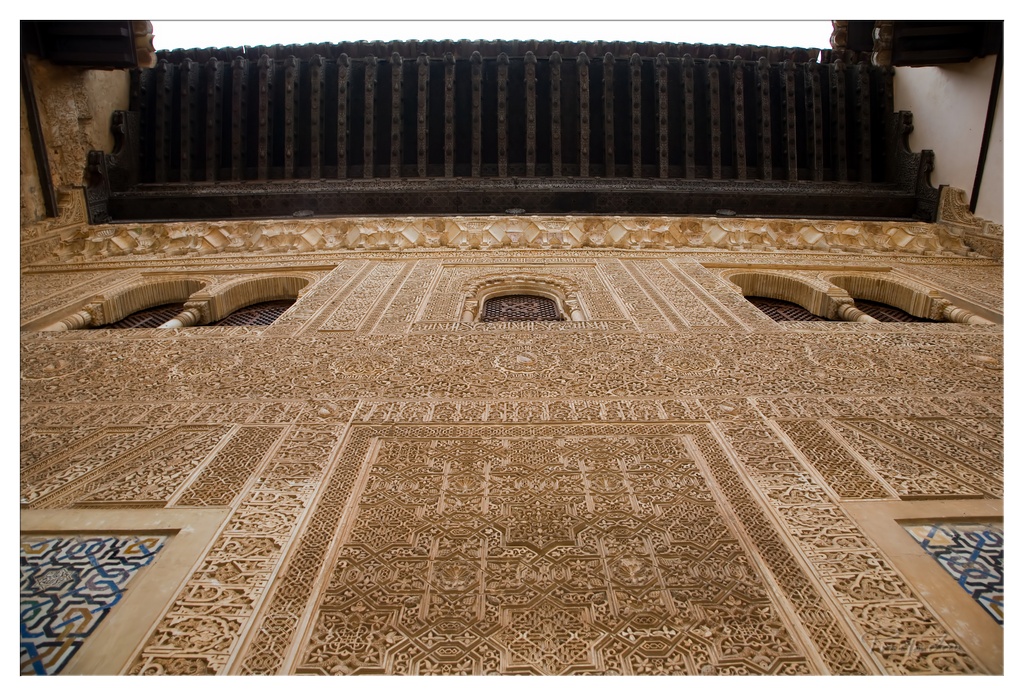

This photo drops us right at the base of an incredibly ornate wall, likely part of a historic palace or mosque, achieving a solid 9/10 for its subject matter's sheer visual impact. Nothing is technically "happening" in this static architectural shot, but the wall itself is a riot of activity, covered head-to-toe in what looks like miles of intricate stucco carving. The mood is one of overwhelming detail and historical grandeur, transporting you back in time and making you appreciate the incredible craftsmanship involved. It feels both imposing due to the low angle and inviting due to the fascinating patterns that draw the eye in every direction.
From a photographic standpoint, the low angle composition is dramatic, emphasizing the height and decorative density of the wall, though it does give the structure a slight leaning-backward effect. The lighting is relatively soft and even, doing a great job of highlighting the delicate textures and shadows within the carvings without blowing out details or creating harsh contrasts. The color palette is dominated by warm, earthy tones of the stucco, beautifully contrasted by the dark, heavy wooden beams of the ceiling structure above. The three arched windows provide a visual rhythm across the upper section of the wall, and the hints of blue and white tile at the bottom left suggest there were pops of vibrant color elsewhere in this complex, offering a tantalizing glimpse beyond the endless beige patterns. It's a shot that celebrates the beauty of obsessive detail, even if it makes your eyes hurt trying to take it all in.
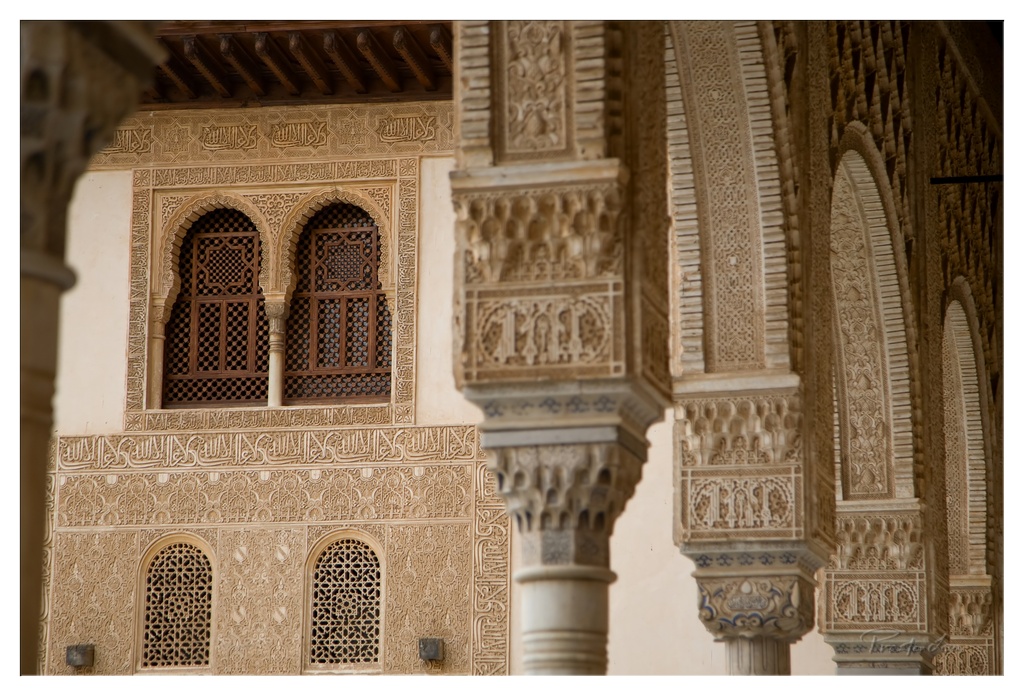

Alhambra Allure
Rating: 9/10
This photograph offers a captivating close-up view of the incredibly detailed architecture of a building, almost certainly within the historic Alhambra palace in Granada, Spain. Nothing dynamic is occurring; the image is a static celebration of craftsmanship and historical design, showcasing walls adorned with intricate carvings, elegant arched windows with decorative wooden screens, and a series of ornate columns and arches receding into the background. The mood is one of serene beauty and historical richness, inviting the viewer to get lost in the complex patterns and textures of the building's facade. The primary subject is the wall section featuring the upper double window and the lower single window, surrounded by dense, almost overwhelming, geometric and calligraphic carvings. These carvings, showcasing Arabic script and complex arabesques, speak volumes about the artistry of the Nasrid period.
From a photographic perspective, the composition is strong, utilizing a shallow depth of field to isolate the main wall section while allowing the foreground column and background arches to gently blur, creating a sense of depth and framing the subject effectively. It's like the photographer is whispering, "Look at THIS!" The lighting is soft and even, perfectly illuminating the relief carvings and highlighting the texture without harsh shadows, allowing every tiny detail to pop – a challenging feat given the complexity. The color palette is dominated by warm, natural tones of beige and brown, reflecting the stone and wood materials and contributing to the image's earthy, timeless feel. The style is typical of architectural detail photography, emphasizing pattern, texture, and historical elements. The sheer amount of detail here is mind-boggling; you can almost hear the chisels chipping away, making you appreciate the centuries of work poured into this place. Honestly, trying to describe all the patterns is like trying to count grains of sand – it's a beautiful, impossible task captured wonderfully here.
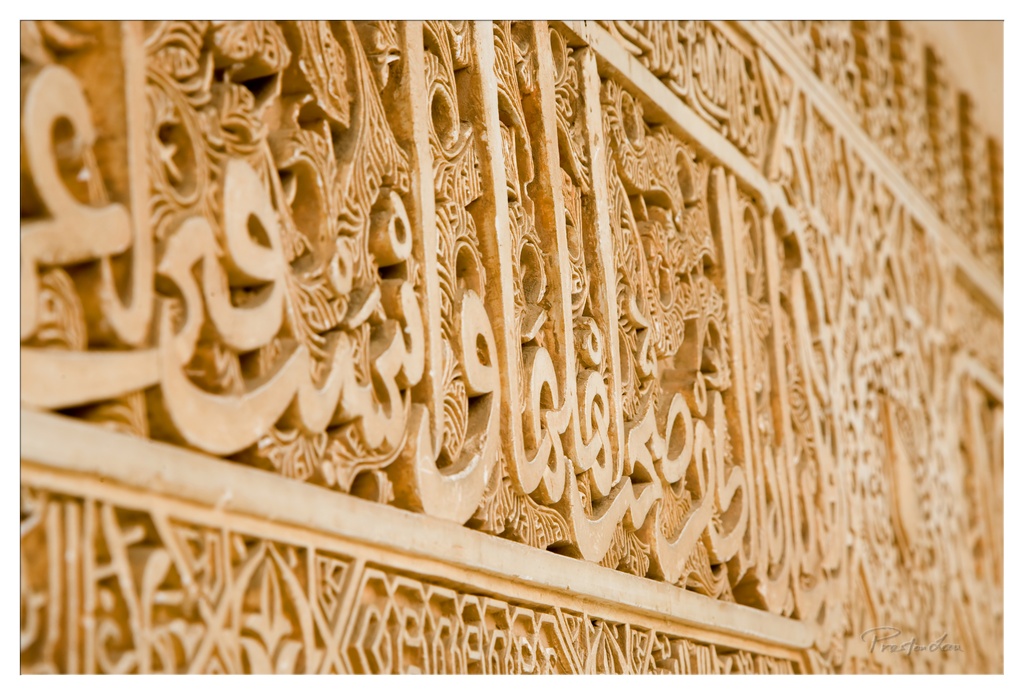

Ancient Whispers on Stone
Rating: 9/10
Here we have a glorious close-up of what appears to be incredibly detailed Islamic calligraphy and geometric patterns carved into a stone or stucco wall. Nothing much is "happening" in the action sense, unless you consider centuries of history whispering from the intricate details. The mood is definitely one of ancient craftsmanship, reverence, and intricate beauty. The sheer level of detail is astounding, making the wall itself the undeniable star of the show, showcasing the artisan's mastery and the timeless appeal of Arabic script and patterns. It makes you wonder about the hands that created it and the eyes that first beheld it in its prime.
From a photography perspective, this shot really leans into the "detail" aspect. The composition uses a strong diagonal line created by the edge of the carving panel, leading the eye across the texture. The focus is deliberately shallow, creating a creamy bokeh in the background (which is just more of the wall, but hey, blurred is better, right?) and helping the sharp, in-focus carving pop. The lighting seems to be directional, possibly side-lighting, which does a fantastic job of raking across the surface and highlighting the depth and shadows of the relief carving – essential for making texture work in photos. The color palette is limited to warm, sandy, earthy tones, which enhances the sense of age and material. It's a classic approach for capturing this kind of subject matter, proving that sometimes, getting really, really close is the best way to appreciate the big picture. Just be careful not to bump it with your lens; that looks expensive (and probably irreplaceable).
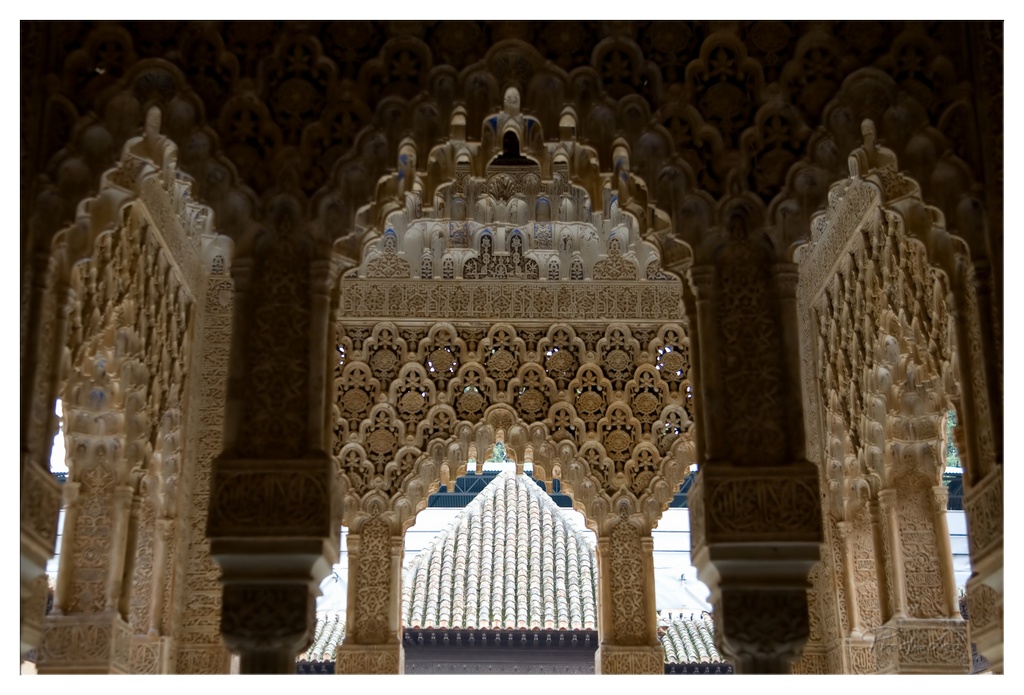

An Archway to Awe
Subject Rating: 9/10
Stepping through this image feels like entering a secret passage in a centuries-old palace, where every surface screams "detail, detail, detail!" We're peering through a series of incredibly ornate arches and decorative screens, each layer piled high with intricate carvings, geometric patterns, and flowing calligraphy. It's a visual feast of muqarnas (those cool honeycomb-like structures) and delicate lattice work that makes you wonder how many skilled hands spent how many years perfecting this. The perspective draws you in, looking past the heavily detailed foreground pillars and arches to a central arched opening that frames a simple, yet effective, tiled roof beyond. The overall mood is one of historical grandeur and quiet mystery, hinting at the stories held within these ancient walls.
From a photography perspective, this is a brave attempt at wrangling a high-contrast, detail-heavy subject. The low light conditions are tricky, but here they work well, creating dramatic shadows and highlights that emphasize the incredible texture of the carvings. The composition expertly uses the existing architecture to frame the shot, creating depth and leading the eye to the central element. However, photographing this level of detail without a single element being pin-sharp across the frame (notice the slight softness on the closest pillars?) is a testament to the challenge – or perhaps a deliberate choice to focus on the overall pattern. Either way, it makes modern minimalist design look positively underemployed.
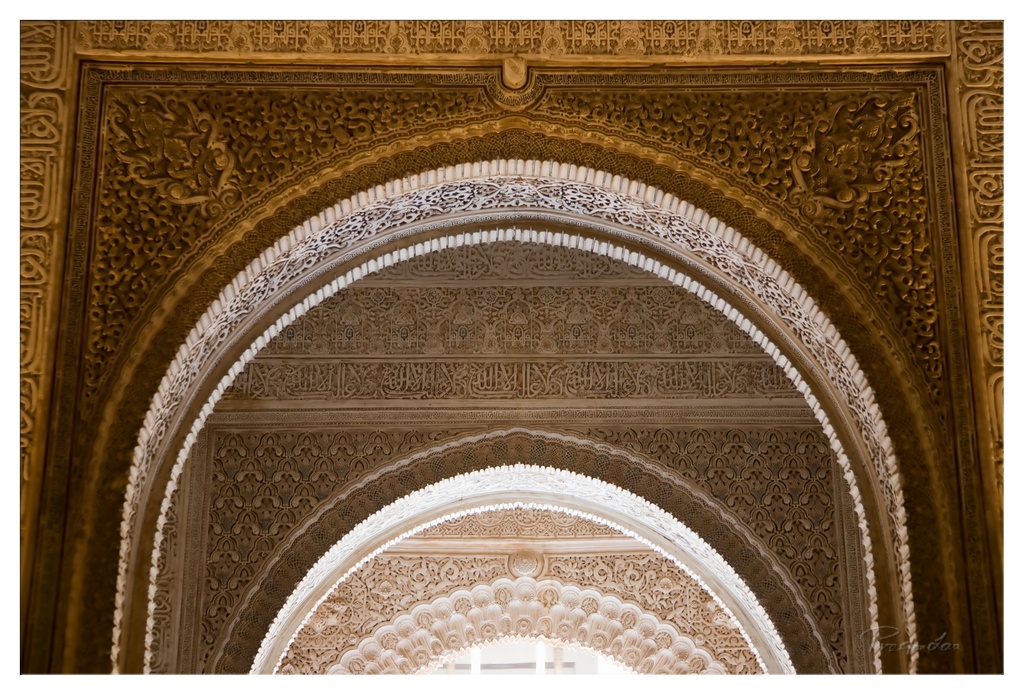

Arches Upon Arches, Ornate Obsession
Subject Rating: 9/10 - Because who needs plain walls when you can have THIS level of intricate, hand-carved magnificence? Seriously, my minimalist decor is suddenly feeling inadequate. We're deep within a stunning architectural marvel, likely a palace or mosque, where multiple ornate arches recede into the distance, showcasing layers upon layers of incredible detail. The mood is one of awe and historical grandeur, like stepping back in time to a place where skilled artisans clearly didn't believe in taking a day off. The pertinent objects here are the arches themselves, carved out of what appears to be stucco or plaster, covered in geometric patterns, floral designs, and elegant Arabic calligraphy. The background is a bright, almost blown-out light source filtering through the furthest arch, suggesting another sunlit space beyond.
From a photography standpoint, the composition expertly uses the receding arches to create depth and draw the eye into the intricate details. It’s a tight crop that eliminates distractions and keeps the focus purely on the craftsmanship. The lighting is soft and diffused, strategically coming from behind the arches, which beautifully highlights the textures and shadows of the carvings, making them pop. While it creates a lovely glow, there are some highlight areas that are quite bright, proving that even centuries-old architecture struggles with tricky dynamic range. The color palette is a warm, almost monochromatic sepia tone, which enhances the feeling of age and richness. The photographer has nailed the focus on the intricate carvings, capturing the sheer density of the detail, making you wonder how many years of squinting and chipping went into creating this visual feast. This shot is a masterclass in appreciating architectural artistry through the lens, even if it might make you want to invest in better sunglasses for those bright highlights.
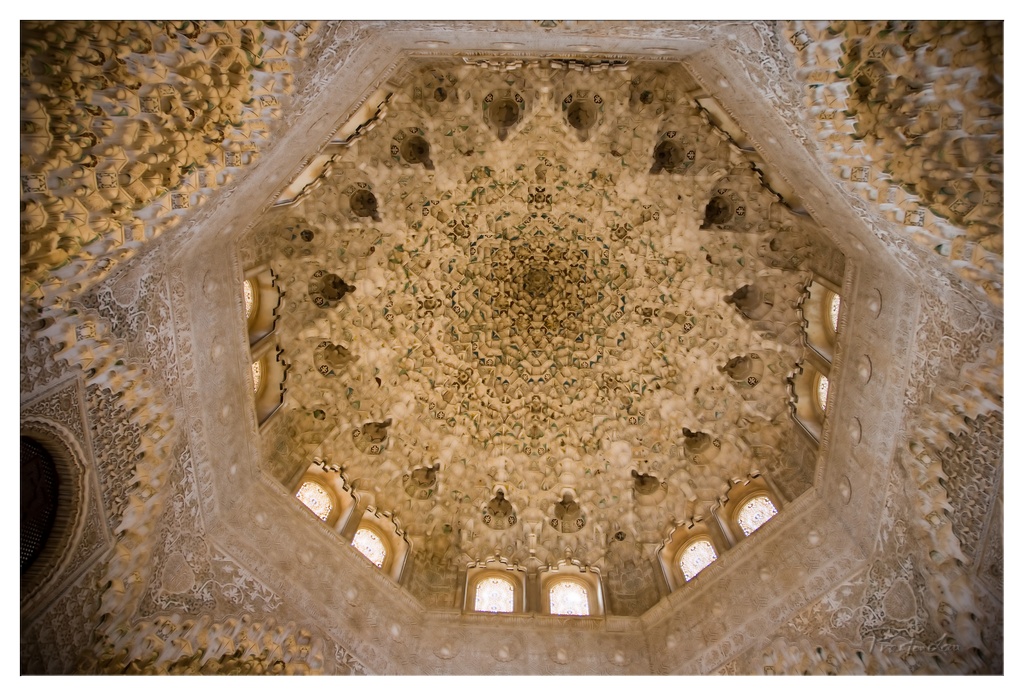

Starry Vault of Granada
Subject Rating: 9/10
This dizzying shot captures the breathtaking muqarnas ceiling of a room within the Alhambra, likely the Hall of the Abencerrajes or the Hall of the Kings, in Granada, Spain. What's happening is the viewer is being transported upwards into a fractal dreamscape of plaster, a testament to incredible Islamic art and architecture. The mood is one of overwhelming awe and intricate beauty, perhaps tempered slightly by the sheer density of detail that almost defies comprehension. The central pattern explodes outwards like a complex star or a honeycomb made of light and shadow, pulling the eye deep into the heart of the vault. The surrounding octagonal structure, punctuated by small windows, serves as the earthly base for this celestial dome.
From a photographic perspective, the low-angle composition directly upwards effectively emphasizes the scale and complexity of the ceiling, albeit at the cost of potential neck strain for the photographer (and the viewer!). The natural light filtering through the small windows, subtly blown out in areas, creates dramatic highlights and shadows that meticulously define each individual muqarna 'stalactite', enhancing the incredible texture. The color palette is predominantly earthy and warm, with shades of beige, cream, and hints of faded green paint or tilework, contributing to the historical and slightly faded grandeur. This is a classic architectural detail shot, focusing on the abstract patterns and the sheer craftsmanship rather than the context of the room itself. It's a visual feast, demanding slow exploration to appreciate the geometric harmony hidden within the apparent chaos of thousands of tiny plaster forms.
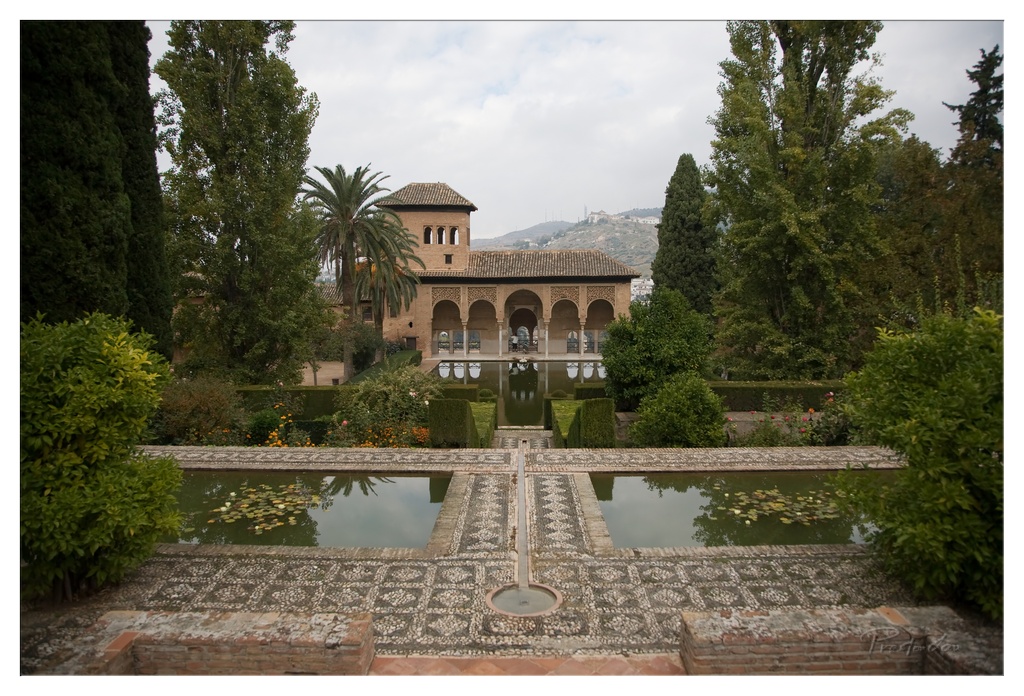

The Serenity of Generalife
Subject Rating: 9/10
This capture transports us to the tranquil beauty of the Generalife gardens within the Alhambra in Granada. The scene unfolds with a classic view looking towards the Palacio del Partal, showcasing its elegant arches reflected in the central pools. The mood is undeniably serene and historic, a moment frozen in time allowing contemplation of centuries-old design. Compositionally, the shot employs strong symmetry with the patterned mosaic pavement and rectangular reflecting pools drawing the eye directly through the formal garden layout towards the building. The vibrant green sculpted hedges provide structure, while large, almost impossibly tall trees (are they trying to block the view or just being dramatic?) frame the image on either side, adding depth and a sense of scale, albeit slightly dominating the left edge. The distant hills and cityscape provide context, grounding this historical marvel within its modern surroundings.
From a technical perspective, the lighting appears to be soft and diffused, courtesy of an overcast sky. While this eliminates harsh shadows and preserves detail across the scene, providing lovely, even light for the earthy tones of the building and the lush greens, it does temper the overall vibrancy. The colors are rich but muted, contributing to the tranquil atmosphere but perhaps lacking the sparkle bright sunlight would bring to the water reflections and foliage. The detail captured is impressive, from the intricate patterns on the pavement to the water lilies in the pools and the architectural details of the palace. It's a solid landscape/architectural shot that relies on the inherent beauty and composition of its subject, proving that sometimes, the best technique is simply being in the right incredibly photogenic place at the right (slightly cloudy) time.
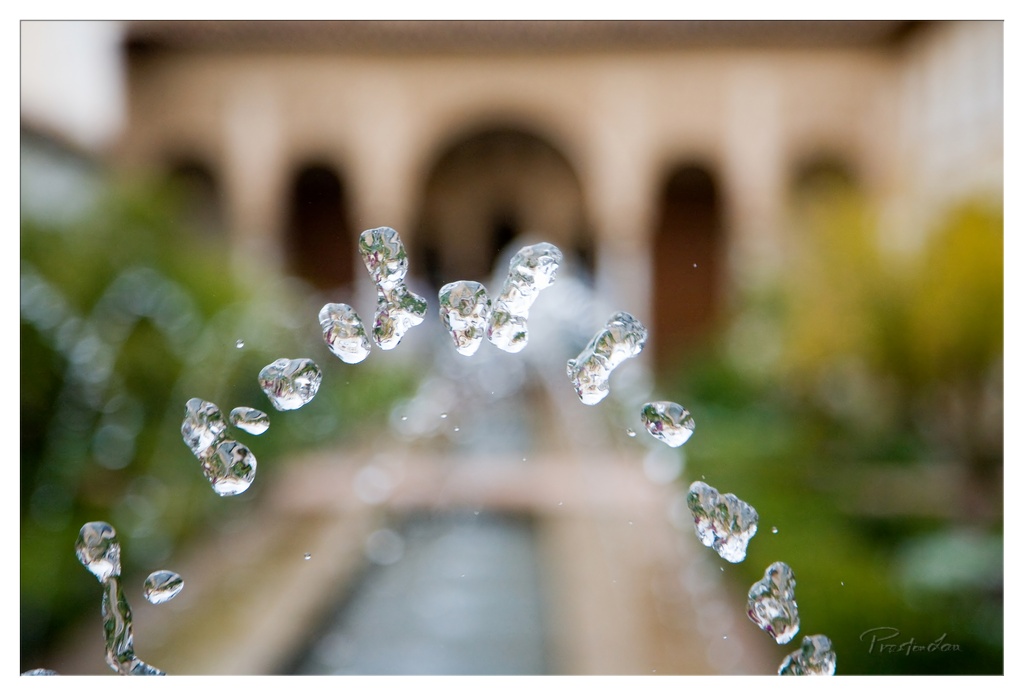

Title: Dancing Droplets in the Alhambra Sun
Rating: 7/10
This image gives us a delightfully refreshing close-up of water droplets suspended mid-air, earning it a solid 7/10 for its captivating subject and execution. What's happening here is a classic fountain shot, but elevated – instead of just seeing the stream, we're treated to the individual globules as they momentarily defy gravity. The mood is serene and almost magical, capturing a fleeting moment of liquid beauty against a softly blurred background. The pertinent objects are, of course, the star water droplets themselves, looking like tiny, distorted crystal jewels, along with the subtly visible spray and larger forms of the water stream below. The background is a beautifully rendered bokeh dream, featuring the warm, arched architecture of what appears to be a Spanish courtyard or garden, framed by lush, out-of-focus greenery and hints of a water channel, hinting at a tranquil, historical setting like the Generalife gardens in the Alhambra.
From a technical standpoint, the composition uses the arc of the water spray to lead the eye across the frame, balancing the sharp, dynamic foreground with the soft, static background. The shallow depth of field is crucial here, isolating the water droplets and transforming the architectural backdrop into a painterly wash of color and light. The lighting is excellent, catching the edges and surfaces of the water droplets to create dazzling highlights and reflections, giving them form and sparkle. The color palette is pleasant and natural, with the cool tones of the water contrasting gently with the warm beiges of the building and the verdant greens and yellows of the garden. It's a style that emphasizes detail and motion within a soft, environmental context. Capturing fast-moving water like this requires a speedy shutter and precise timing – hats off to the photographer for freezing these little liquid dancers mid-leap! It's a shot that perfectly marries the simple beauty of nature with the elegance of its surroundings.
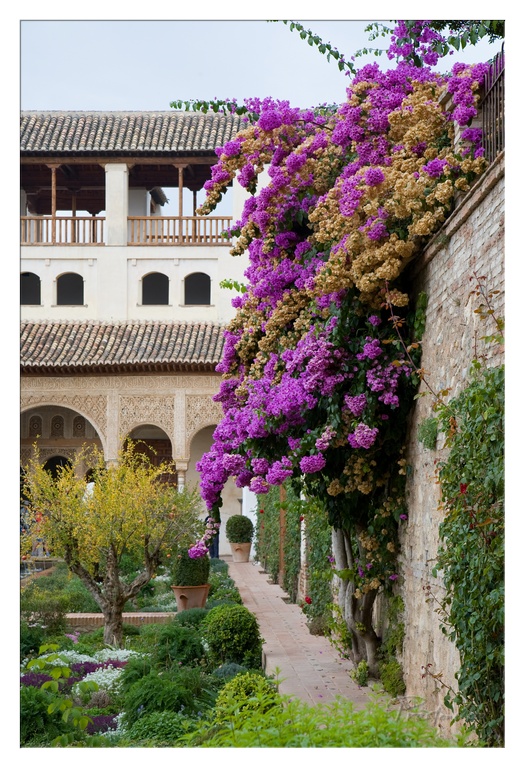

Alhambra Bloom and Architectural Grace
Rating: 8/10
This image captures a moment of tranquil beauty within a historic setting, likely somewhere like the Alhambra with its distinctive Moorish architecture and elaborate gardens. The main subject is arguably the magnificent bougainvillea vine cascading over a brick wall, a riot of vibrant purple flowers intermingled with older, faded ochre blooms. Below, a meticulously tended garden path leads the eye towards an arched walkway, providing a sense of depth and invitation. The mood is serene and picturesque, almost like stepping back in time into a peaceful courtyard. Pertinent objects include the stunning floral display, the detailed carved arches of the building, the patterned tile roof, arched windows, and neatly trimmed garden beds, all contributing to the rich visual tapestry. The background features the upper levels of the building with its wooden balcony, hinting at the grandeur of the structure.
From a photography standpoint, the composition uses leading lines effectively with the garden path and the cascade of the vine drawing the viewer in. The soft, diffused lighting is ideal, minimizing harsh shadows and allowing the vibrant purple and varied textures to shine. The color palette is rich and harmonious, with the bold purple and earthy browns of the vine contrasting beautifully with the warm tones of the architecture and the lush greens of the garden. The subject matter is classic travel photography – capturing the essence of a famous, beautiful location. However, the sheer volume and contrast between the living purple and decaying brown flowers on the vine add a layer of poignant complexity. It's a lovely shot, perhaps slightly busy visually, but it successfully conveys the charm and beauty of the location. The vine is definitely stealing the show, as any good floral drama should.
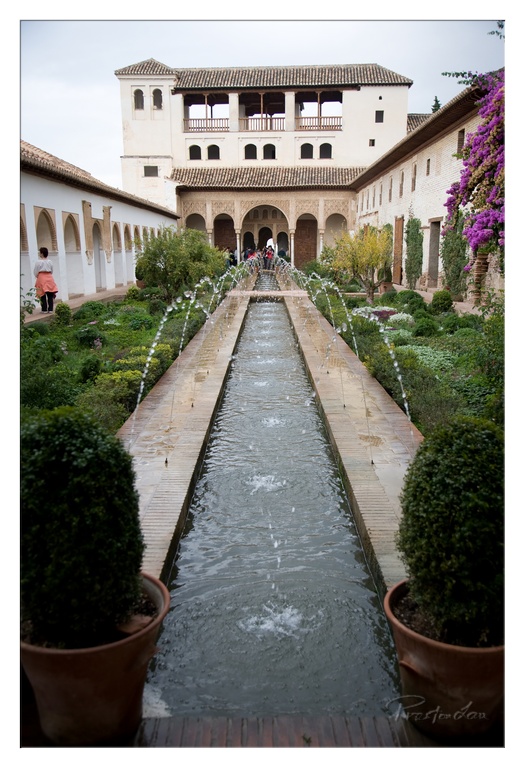

Not Just Any Garden Hose
7/10
Ah, the classic Spanish garden shot! We've got a lovely 7/10 subject rating here – who doesn't love a serene water feature nestled within historic architecture? This image perfectly captures the formal beauty of a long, rectangular canal stretching into the distance, punctuated by jets of water playfully arcing into the air like tiny liquid acrobats. It feels peaceful, almost meditative, despite the faint presence of fellow tourists milling about in the background, adding a touch of realistic hustle to the historical tranquility. The mood is undeniably serene, inviting you to imagine the gentle murmur of the fountains and the cool shade of the surrounding gardens, probably somewhere like the Generalife gardens in the Alhambra, famous for its intricate water features and calming atmosphere.
From a photographic perspective, the composition leans heavily on symmetry and leading lines, pulling your eye straight down the canal towards the ornate buildings at the end – a classic move, though maybe not the most original angle for such a famous spot. The overcast lighting provides a soft, even exposure, which is great for preserving detail and avoiding blown-out highlights, but it does leave the scene feeling a bit flat. A touch of dramatic golden hour light could have added some much-needed punch and warmth. The color palette is dominated by the warm earth tones of the bricks and buildings, the lush greens of the garden, and the cool blues and greys of the water, with a cheerful burst of purple bougainvillea adding a welcome splash of vibrancy on the right wall. While the potted plants framing the foreground add a sense of depth, their placement feels slightly awkward, like they're trying to subtly edge into the frame. Overall, a solid, well-executed shot of a beautiful place, capturing its essence even without dramatic lighting. Just be careful not to fall in while trying to get that perfect low-angle shot!
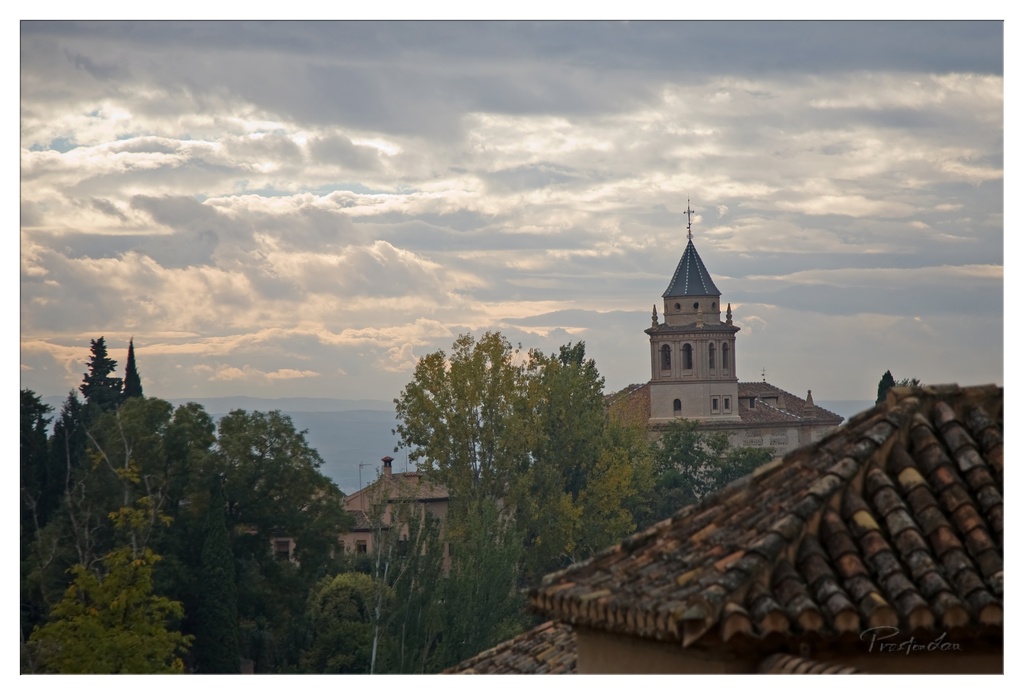

Rooftop View of Cloudy Spires
7/10
This is a moody shot of a charming European cityscape, observed from a viewpoint overlooking a sea of tiled roofs. The star of the show is clearly the elegant church tower rising above the surrounding buildings and trees, reaching towards a dramatic, cloudy sky. It feels like a moment captured just as the light is breaking or fading, giving the scene a slightly ethereal quality. The composition effectively uses the busy foreground roof texture to lead the eye into the mid-ground cluster of trees and buildings before settling on the architectural focal point of the tower. It's a classic vista, presented with a hint of atmospheric gravitas.
From a technical perspective, the soft, diffused light from the overcast sky prevents harsh shadows but leaves the scene with relatively low contrast and a muted color palette, leaning heavily into earthy tones. While the layering in the composition is strong, the foreground roof, while texturally interesting, is slightly out of focus, which might niggle those who crave perfect sharpness throughout – unless it was a deliberate artistic choice for depth, in which case, well played! The sky dominates the frame, adding significant character, though perhaps a stronger burst of light could have elevated the tower further. Overall, it's a solid capture that evokes the feeling of a particular place and time, proving you don't always need direct sun to make a scene compelling, just maybe a little more pop!
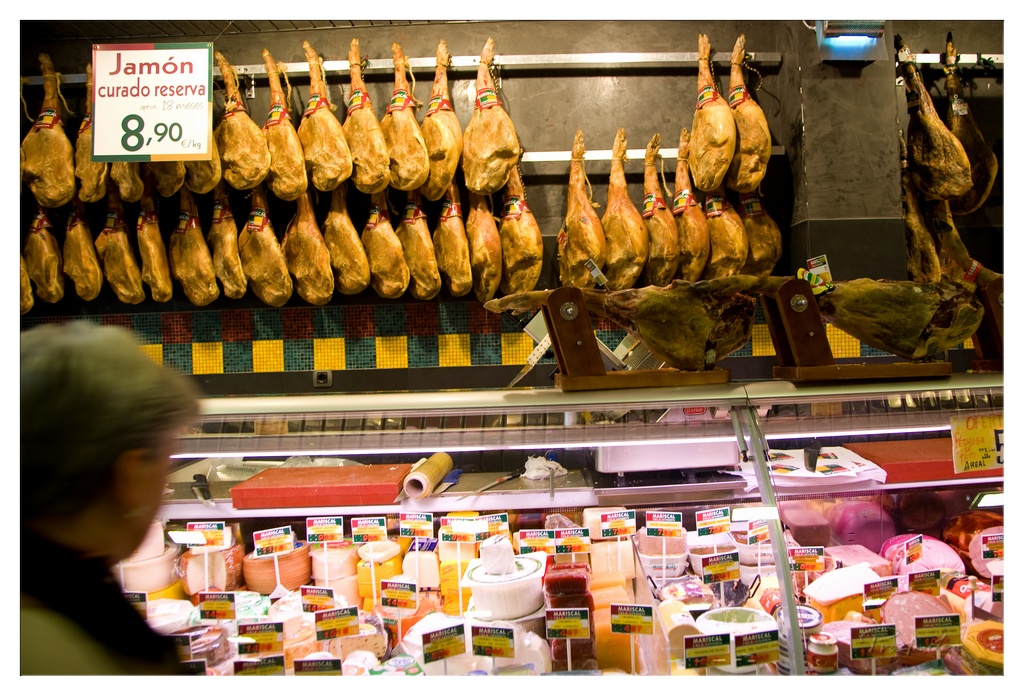

A Ham Haven of Hanging Hogs
Rating: 8/10
Step right up to this Spanish deli extravaganza, a scene that could make a vegetarian question their life choices. Dominating the frame is a magnificent display of hanging jamón legs, a veritable cured meat curtain offering "Jamón curado reserva" at a very tempting 8,90 €/kg. Below this meaty canopy lies a treasure trove of cheeses, sausages, and other deli delights, crammed into a refrigerated display case, each item vying for attention with its colorful label and plump appearance. A customer, slightly out of focus in the foreground, adds a touch of human scale and hints at the bustling activity of the shop, their gaze seemingly lost in the delicious options before them. The overall mood is one of abundance and sensory overload, capturing the rich, flavorful spirit of a traditional European food market.
From a photographer's perspective, this shot is a masterclass in capturing visual density. The composition expertly layers the scene, starting with the soft blur of the browsing customer, moving to the packed display case with its myriad textures and colors, and finally reaching the impressive, repetitive pattern of the hanging hams against the dark wall above colorful tiles. The lighting, likely a mix of overhead store lights and case illumination, does a decent job highlighting the glossy fat and deep red flesh of the jamón, although it creates some challenging reflections on the glass case below – a common headache when photographing food displays. The color palette is rich and warm, dominated by the earthy tones of the meats and cheeses, punctuated by the bright pops of the yellow and red price tags. It’s a busy image, but effectively conveys the sheer variety and appeal of the products on offer, inviting the viewer to almost smell the savory aroma.
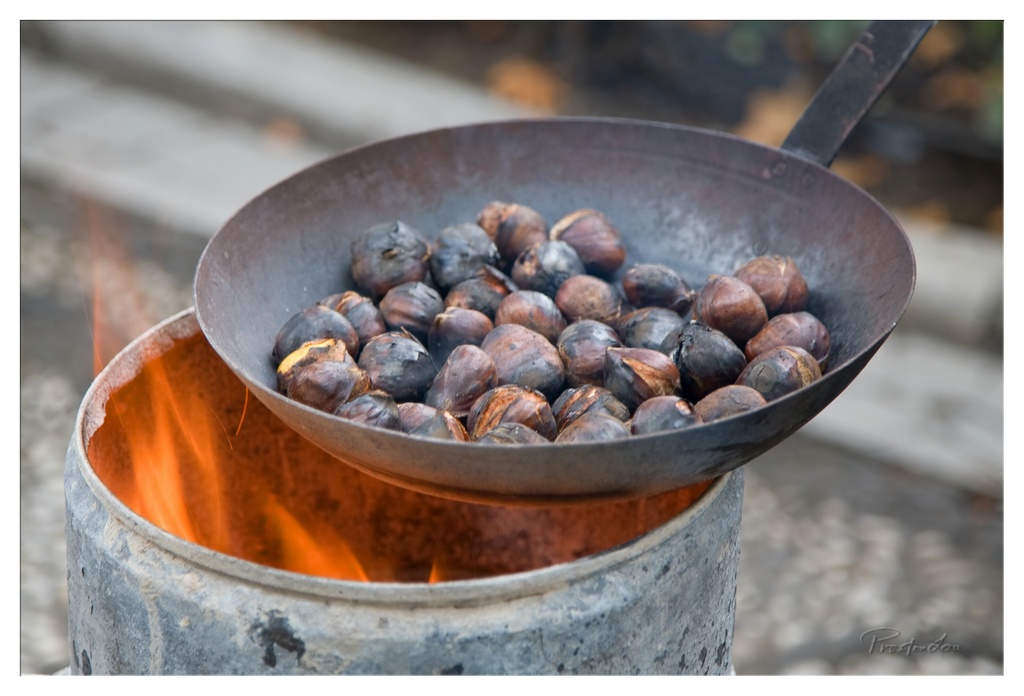

Roasted Goodness, Street Style
Rating: 8/10
This image captures the quintessential autumnal scene of chestnuts being roasted over an open fire. Piled high in a well-worn, dark metal pan, the chestnuts are the undeniable stars, their cracked and charred skins hinting at the smoky deliciousness within. The pan itself rests precariously over the glowing orange and yellow flames leaping from a rustic metal barrel, suggesting a traditional, perhaps street-side, method of preparation. The mood is warm, cozy, and invites the viewer to imagine the crackling fire and the earthy aroma of the roasting nuts. It’s a simple moment, beautifully rendered.
From a photographic perspective, the composition is strong, with the pan slicing dynamically across the frame and the shallow depth of field expertly isolating the chestnuts against the blurred background of what appears to be pavement or cobblestones. The lighting is dominated by the intense, warm glow of the fire from below, casting a fiery halo and dramatic shadows on the pan and nuts. This provides fantastic contrast against the darker tones of the subject matter and the cool grey of the barrel. While the setup looks like it might be just one brisk breeze away from disaster, it certainly makes for a compelling subject. A solid shot for any photographer looking to capture a slice of seasonal culinary tradition.
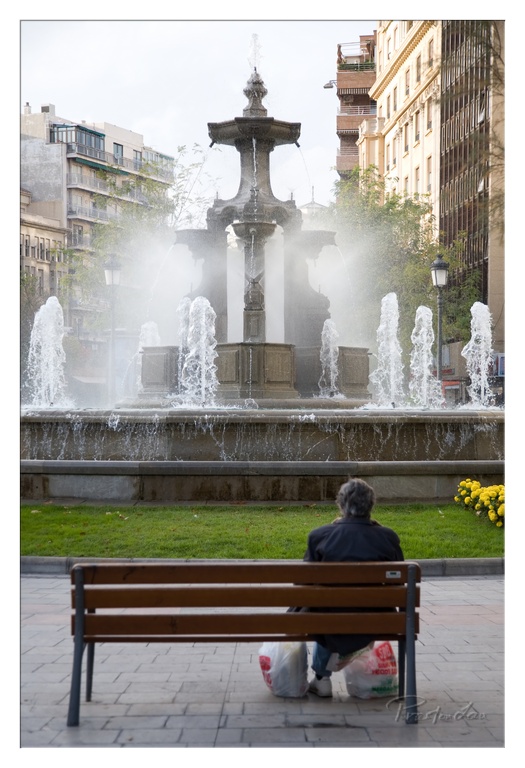

Title: Fountain of Contemplation (or Just Really Tired From Shopping)
Subject (Person on Bench): 6/10
Ah, the classic "post-retail therapy recovery" pose. Our lone protagonist, rated a solid 6/10 for the sheer relatability of their situation, is parked firmly on a bench, strategically positioned near a majestic, multi-tiered fountain that's clearly the star of this urban stage. What's happening? A moment of respite, a quiet sit-down after battling the shops, evidenced by the tell-tale plastic bags huddled protectively by their feet. The mood is wonderfully calm and perhaps a touch introspective, a small island of peace in what is likely a bustling city square. The grand fountain, gushing water like it's just won the lottery, provides the dramatic backdrop, its intricate stone work contrasting with the simple wooden bench and the very modern, very full shopping bags – a delightful juxtaposition of the grand and the mundane.
From a photographic standpoint, the composition is quite effective, using the relatable foreground subject slightly off-center to subtly draw the viewer's eye back towards the impressive fountain, which sits proudly as the main focal point in the middle ground. The background of city buildings adds context to the urban scene. The overcast lighting, while perhaps a touch flat and leaving the sky looking decidedly uninspired, provides beautifully soft, even illumination, preventing harsh shadows and allowing the intricate detail of the fountain's carving and the textures of the surrounding buildings to come through clearly. The color palette is primarily composed of muted greys and greens from the stone, pavement, grass, and sky, making the warm brown of the bench, the bright red/white of the shopping bags (a subtle splash of consumerist colour!), and the unexpected pop of cheerful yellow flowers on the right particularly noticeable. This image successfully captures a quiet, contemplative human moment within a grand urban landscape, demonstrating that sometimes the most compelling scenes involve just a person, a bench, and a well-earned break.
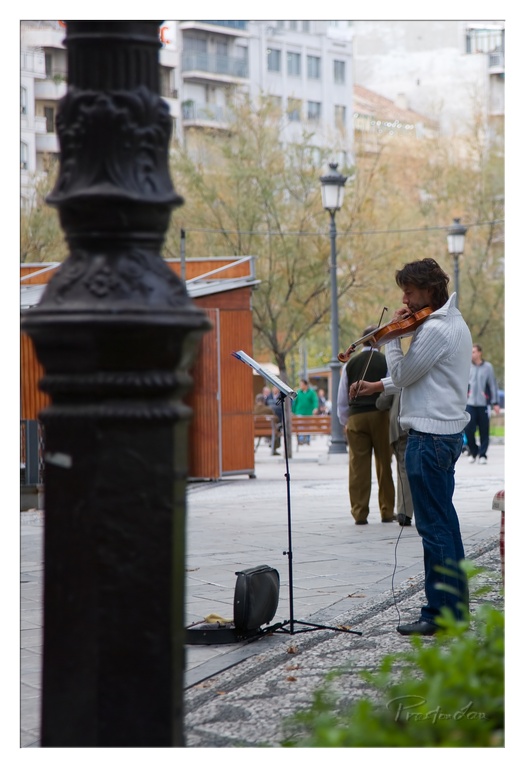

Title: Street Serenade, Framed by Iron
Rating: Subject (Musician): 7/10
Ah, the timeless allure of street performance! Here we have our subject, a violinist earnestly pouring his soul into the pavement, rated a solid 7/10 for effort and potential public disruption. He's perched precariously mid-frame on the right, accompanied by his trusty violin, a surprisingly modern speaker setup (gone are the days of just a hat on the ground!), and a music stand that somehow avoids being blown over by the sheer force of his musical passion. The scene unfolds in a public square, hinted at by the detailed cobblestone pavement and the distant blurry figures who are either captivated or just trying to get past. The mood is one of quiet dedication and focus, perhaps a touch hopeful for loose change, surrounded by the everyday bustle of urban life and the architectural backdrop of apartment buildings and public stalls.
Now, let's talk shop. Compositionally, the photographer has boldly opted for the "Giant Iron Obstacle" technique, placing a rather imposing, albeit decorative, black lamppost almost center-left, dramatically out of focus. While it certainly adds depth and a strong foreground element, effectively framing the scene, you can't help but feel it's competing for attention – perhaps the lamppost is the real, stoic listener? The subject violinist is isolated with a generous amount of creamy bokeh, courtesy of a wide aperture, effectively melting the background of trees, stalls, and unsuspecting pedestrians into a soft, abstract wash. The lighting is pleasantly soft and even, suggesting an overcast day or well-timed shade, avoiding harsh highlights or shadows and allowing the details on the subject and the lamppost to stand out. The overall color palette is subdued, letting the musician's bright white sweater stand out slightly against the warmer tones of the stalls and the cool urban greys and blues. It's a classic street photography approach, using depth of field to pull the subject forward, even if the lamppost decided it needed a significant slice of the frame.
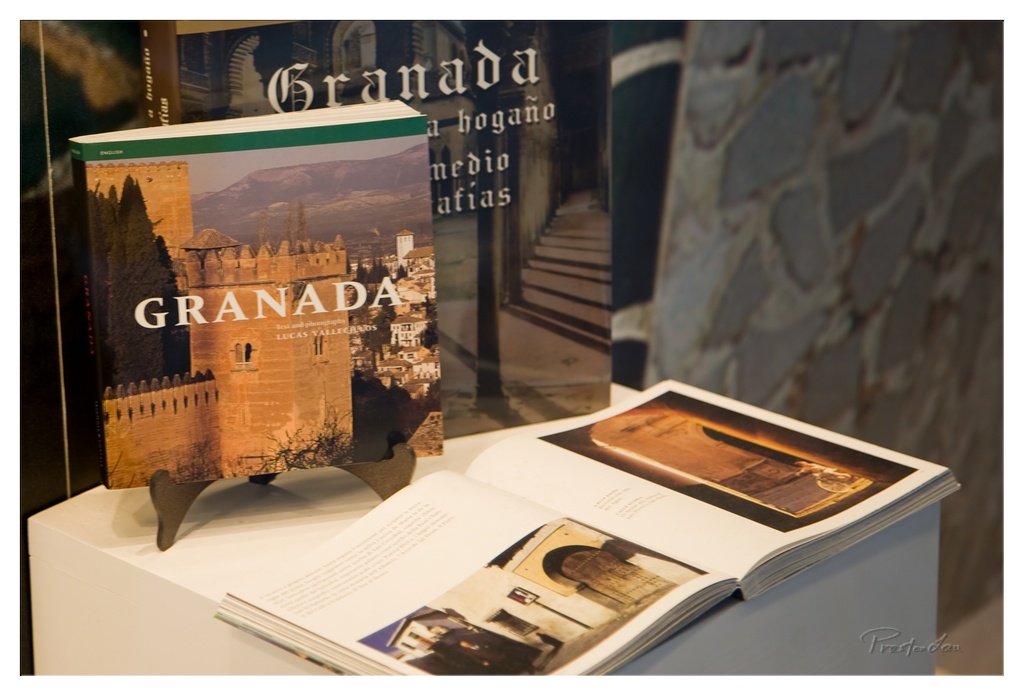

Bookworm's Guide to the Alhambra (or just Granada, really)
Rating: 7/10
Here we have a classic display setup for a book enthusiast's catalog shot, starring a collection dedicated to Granada. What's happening is straightforward: a few impressive volumes are artfully arranged on a clean white surface, designed to entice potential readers (or maybe just decorators who appreciate a good spine). The mood is quietly academic, suggesting a deep dive into culture and history, though perhaps slightly intimidating depending on your reading speed. From a photographer's standpoint, the composition is pleasingly balanced, with the upright book acting as a strong anchor, supported by the open volume in the foreground that invites closer inspection. The soft, diffused light from the left bathes the scene, highlighting the textures of the covers and pages without harsh glare – a solid choice for product photography, although one might joke that it makes the reading list look deceptively relaxing.
Zooming in, the subject matter is clearly defined: the beautiful architecture and history of Granada, predominantly featuring imagery of the iconic Alhambra. The color palette is warm and inviting, dominated by the golden hues of the historical buildings against blue skies and earthy tones, contrasted nicely by the crisp white of the table and book pages. The lighting is key here, creating gentle shadows that add depth to the book spines and the open pages, showcasing the detail in the printed images. The background, a softly blurred stone wall texture and hints of another large, dark object, provides context and visual interest without competing for attention, demonstrating a smart use of shallow depth of field. Overall, it's a clean, effective presentation of the subject, proving that even books can be captivating subjects when lit and composed with care – though perhaps it requires a slightly less technical caption for the average bookstore browser.
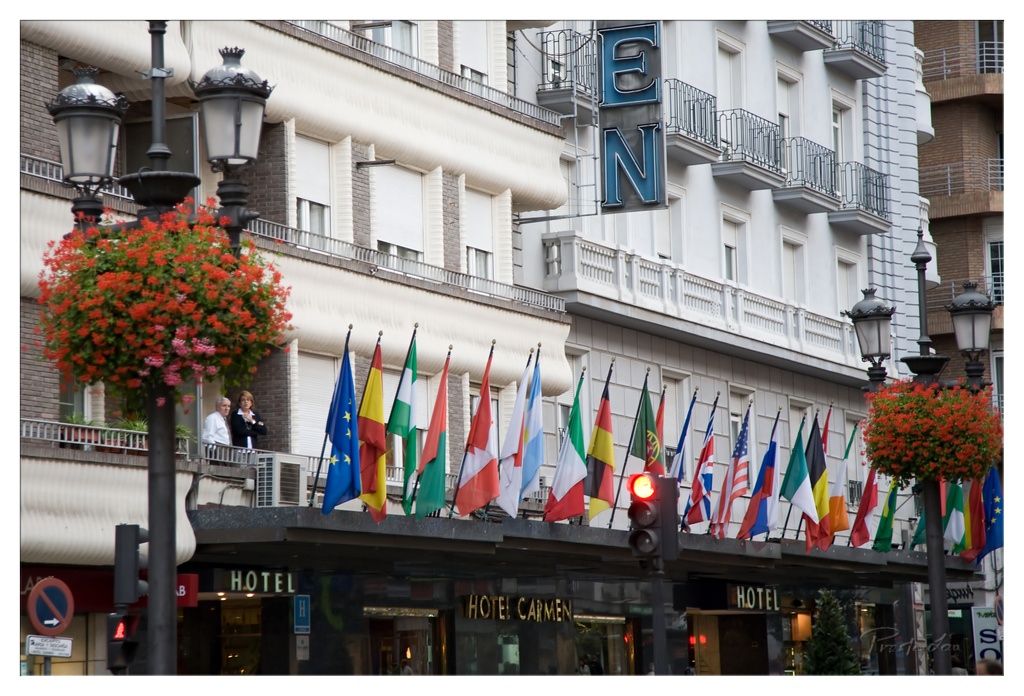

Hotel Carmen: A United Nations of Facades
Subject Rating: 7/10
This image presents a rather busy scene centered on the facade of the "HOTEL CARMEN," adorned with an impressive, if slightly overwhelming, collection of international flags. On a balcony above, a couple appears to be taking in the view, perhaps contemplating which nation's flag represents their next holiday destination. To the left, a large, ornate street lamp laden with vibrant red and pink flowers dominates the foreground, almost attempting to upstage the architectural subject itself. The overall tone is one of lively urban presence, perhaps a touch formal given the flags, but grounded by the everyday details like the traffic light displaying red below. It captures a specific moment on a street corner, bustling with visual information.
From a photographic standpoint, the composition is packed. The lamp post on the left acts as a strong vertical anchor but also feels a bit close, perhaps unavoidable from the shooting position. The horizontal line of flags is a compelling element, though their sheer number creates visual noise – identifying them all could be a fun, albeit tedious, game. Lighting appears to be soft and diffused, likely from an overcast sky, which is great for keeping details in the building facade sharp but does result in a somewhat flat look lacking dramatic shadows or highlights. The pop of color from the flowers and the flags is essential, preventing the muted tones of the building from becoming monotonous. It’s a snapshot that tries to capture a lot at once, giving a comprehensive but perhaps slightly cluttered view of this particular urban corner.
Loading map...